North America has over 2000 bird species and many of these are little birds. If your internet search has led you here, you most likely have seen a small bird and you are wondering what it is called. This article is going to introduce you to some of the amazing and beautiful small birds of North America.
As there are so very many small birds that can be seen in the United States, I have kept this post to some of the most common birds. I have also only included birds that are around 5.9″ (15cm) in length or less.
As an Amazon Associate, I earn from qualifying purchases. Birdwatch World earns commissions from Amazon and similar affiliate programs from any purchases made via links in this article.
- 1. Calliope Hummingbird
- 2. Carolina Chickadee
- 3. Black-throated Green Warbler
- 4. American Goldfinch
- 5. Common Yellowthroat
- 6. Red-eyed Vireo
- 7. Indigo Bunting
- 8. Yellow-rumped Warbler
- 9. Carolina Wren
- 10. Common Redpoll
- 11. Black-capped Chickadee
- 12. Chipping Sparrow
- 13. Tree Swallow
- 14. Song Sparrow
- 15. White-breasted Nuthatch
- 16. House Finch
- 17. Blackpoll Warbler
- 18. Dark-eyed Junco
- 19. Tufted Titmouse
- 20. Downy Woodpecker
- References
1. Calliope Hummingbird
At just 3.1 to 3.5 inches (8-9cm) in length, the Calliope Hummingbird is the smallest bird in North America and thus HAD to be the first one on this list.
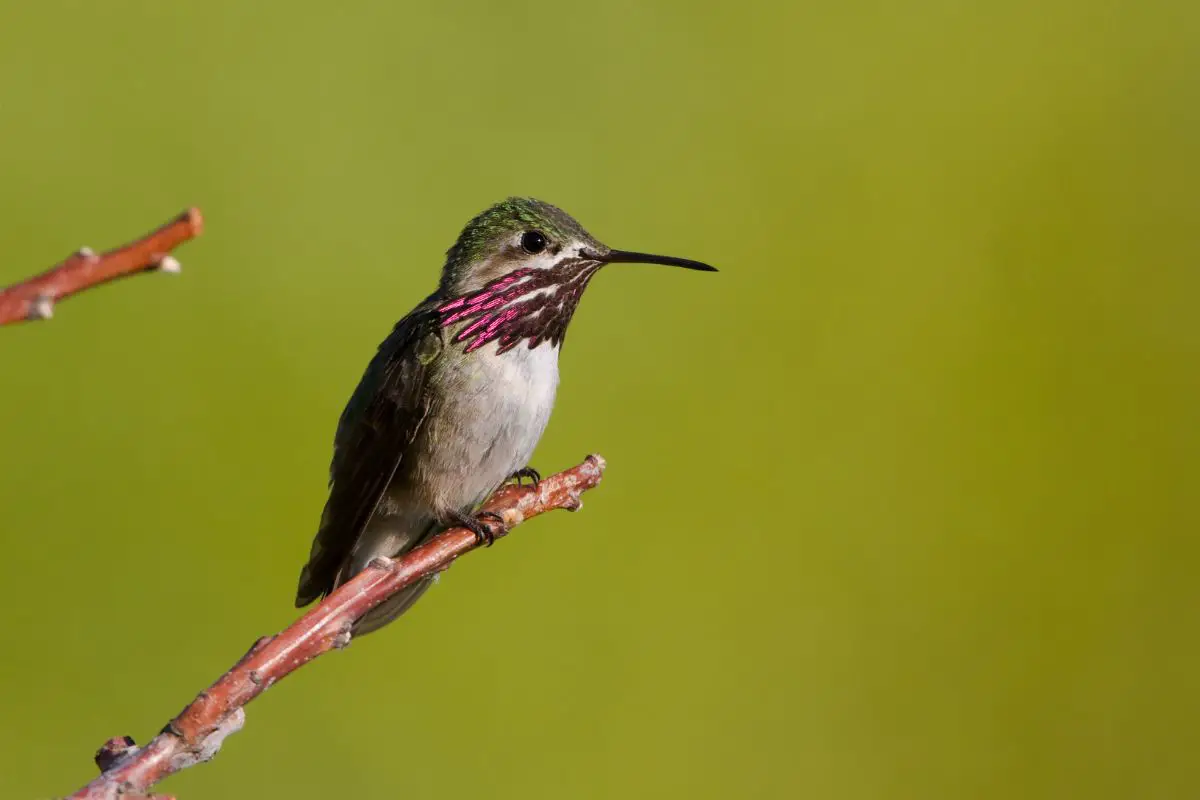
The male Calliope is glossy green on the back and crown and has white underparts. His gorget (patch of feathers on the throat) has wine-red streaks and is the most stunning feature of this bird. The flanks and tail of the male are green.
The female Calliope Hummingbird has a glossy green back and crown also with white underparts. She also has a pinkish wash on her flanks, dark streaks on her throat and her tail is dark, almost black, with white tips. Immature calliopes have colorings like the female.
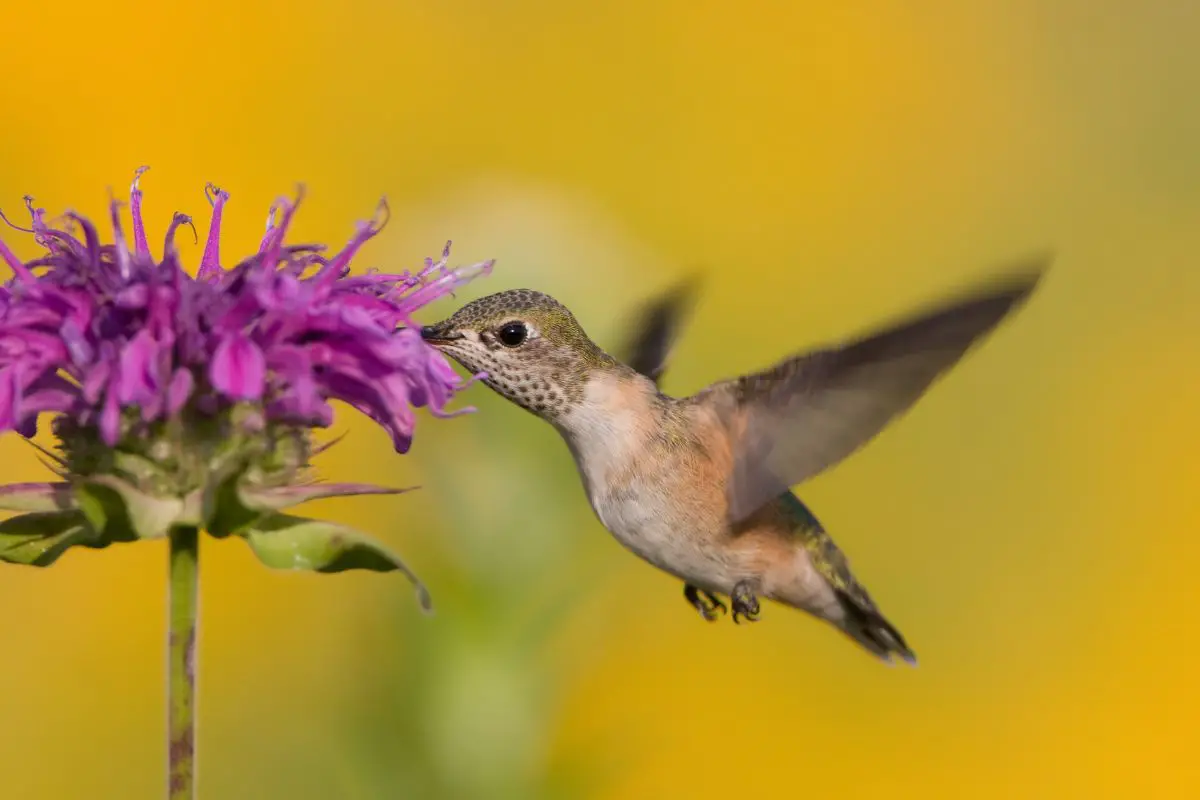
Calliope Hummingbirds can be found in forest glades and canyons in the western states. They like shrubby areas near streams.
Watch this little wonder in action and learn a little more about them in this video from Jo Alwood:
Audubon.org lists 19 species of Hummingbird in North America and I could happily just fill this list with them! We must however explore some other small birds…
Find out what the most common small bird in the United States is in this article here on my site.
2. Carolina Chickadee
These little birds are just too cute?!
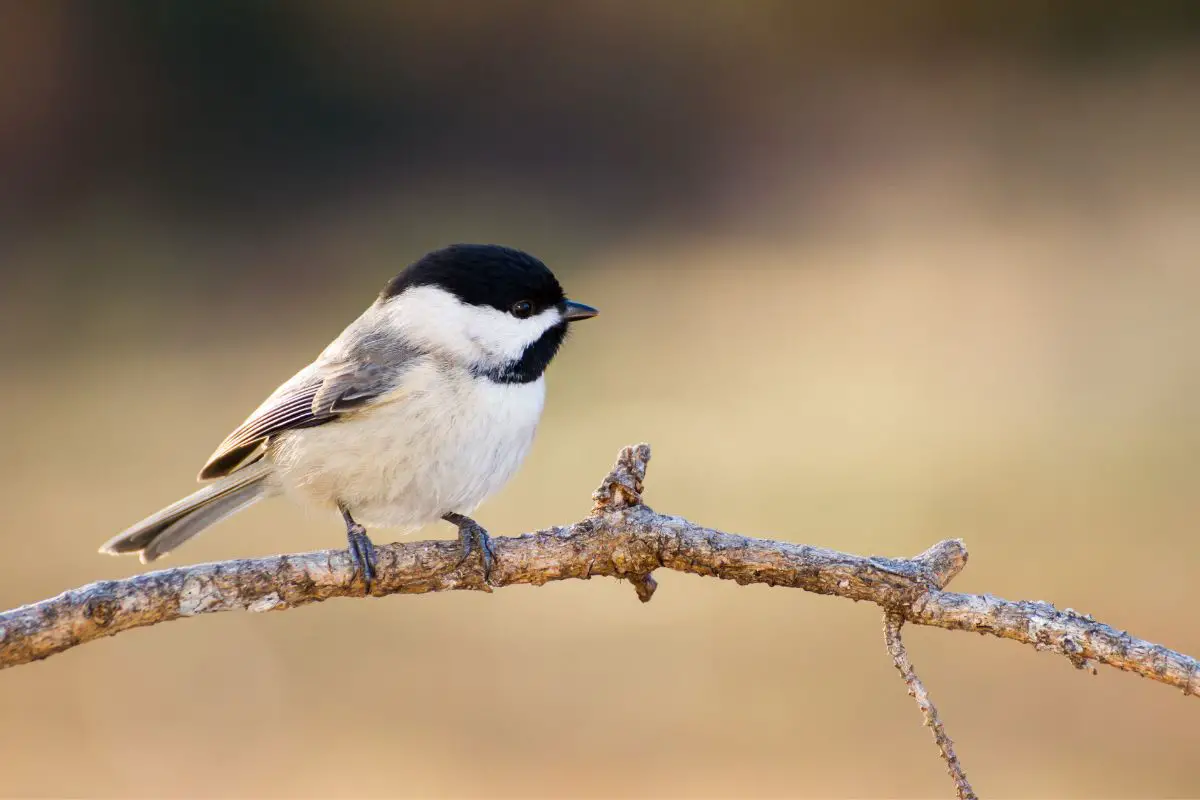
Just 3.9 to 4.7 in. (10-12cm) long, the Carolina Chickadee is a tiny passerine bird (songbird) found in the southeastern states. They are very similar to the Black-capped Chickadee which we will look at later in this article.
Males and females are very similar, both having black caps and bibs with white cheeks. Their backs are gray and underneath they are white with rusty-colored flanks.
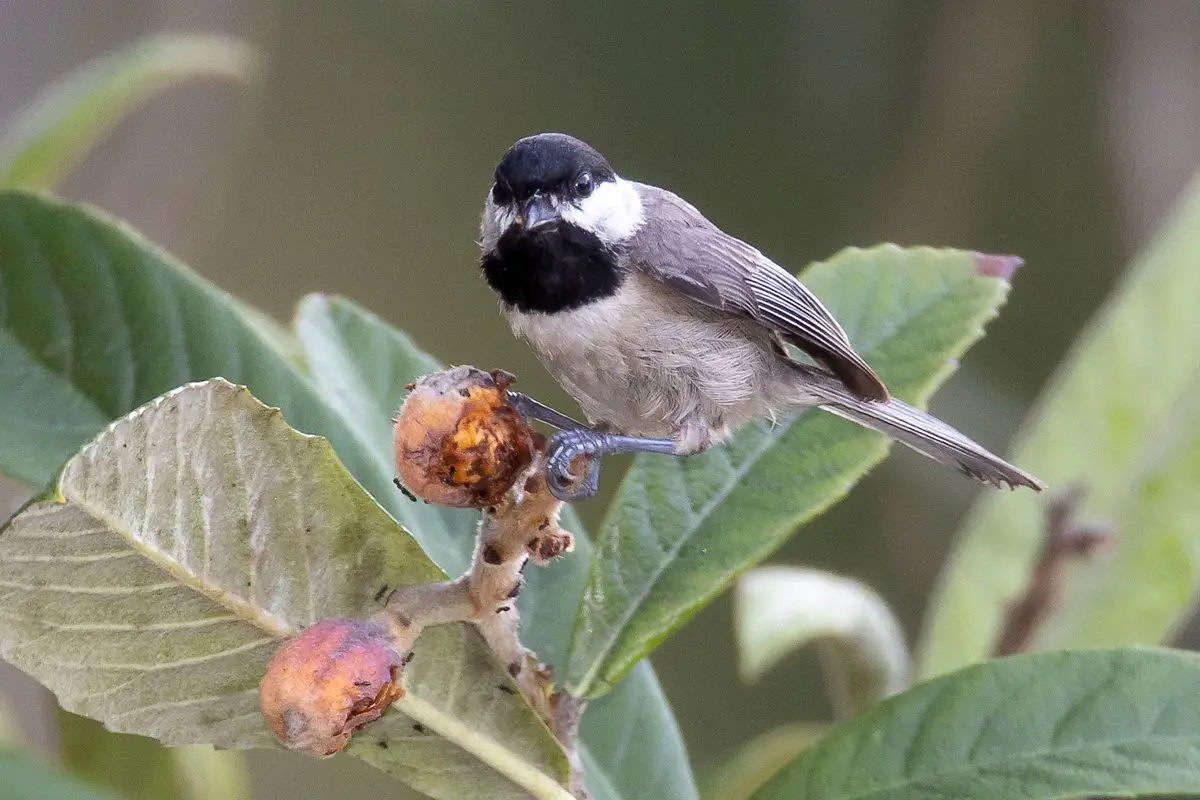
You will spot these small birds in forested areas, as well as urban and suburban backyards, though they will visit feeders less often than Black-capped Chickadees.
Learn about the amazing language of Chickadees in this article here on my blog.
Watch the video from Birds Walking Down below to see and hear these cute little birds in action:
3. Black-throated Green Warbler
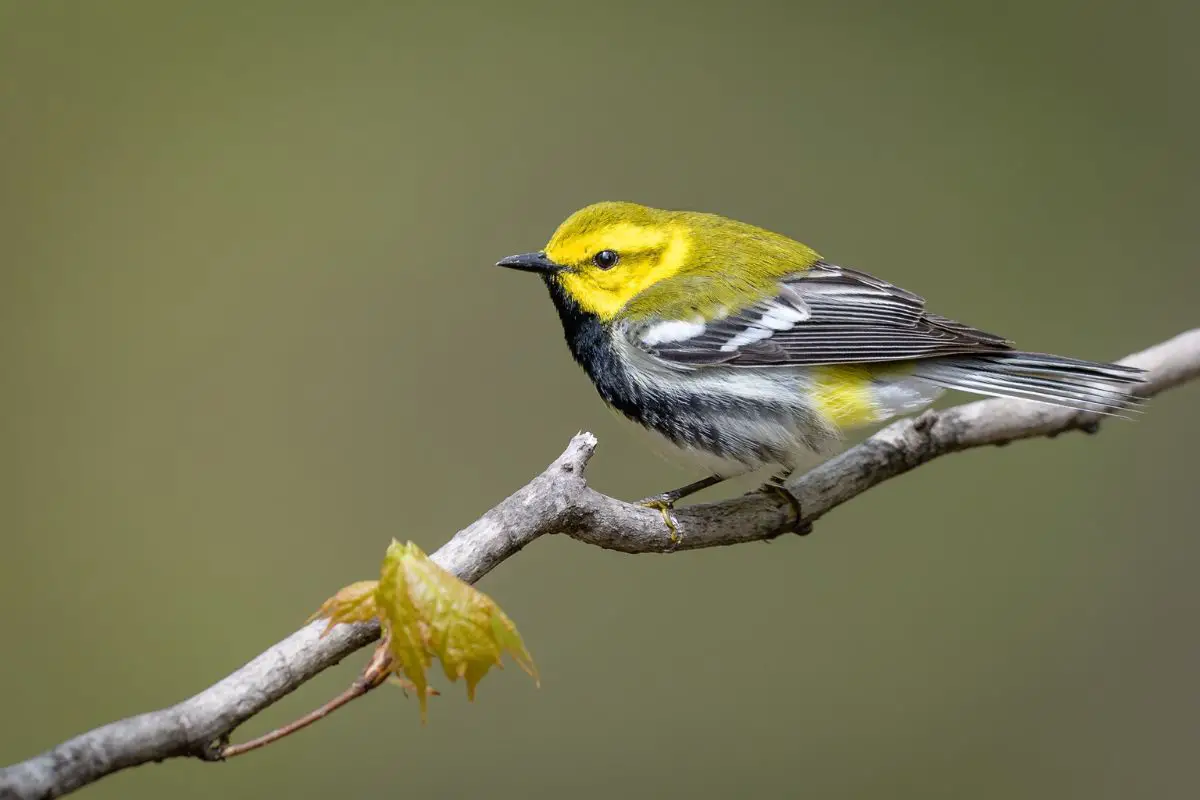
At 4.3 to 4.7 in. (11-12cm) in length, this little cutie is the next bird on our list.
The male Black-Throated Green Warbler is distinguished by its black throat and yellow and olive face. It has white bars on its wings, an olive back, pale underparts, and black streaks on its flanks. Adult males will have a black throat and upper breast.
The female, seen below, has a pale throat and black markings on her breast.
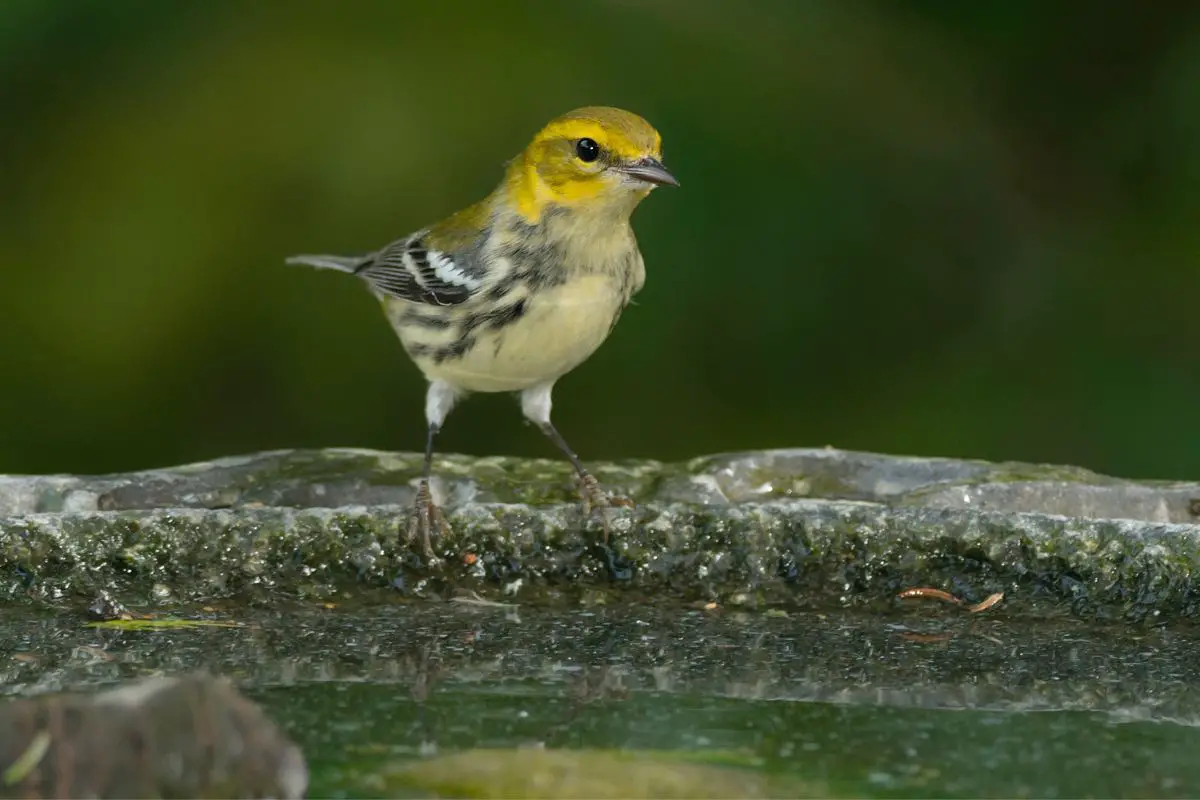
Get some great ideas for birdbaths to attract more birds to your backyard in this article.
These birds can be found in the Mid-Western, South-East, Mid-Atlantic, and North-Eastern states. You will also see them in Texas and Oklahoma. They prefer conifers and will often nest in spruce, white pine, hemlock, red cedar, and jack pine.
To see their behavior and hear their call, watch the YouTube video below from Larry Bond:
Learn more about other American birds in the Sibley Guide To Birds, Second Edition. Guy McCaskie from Birding Magazine calls it “the finest guide to North American birds.” Explore pricing and buying options from Amazon, Walmart, or eBay via the button below:
4. American Goldfinch
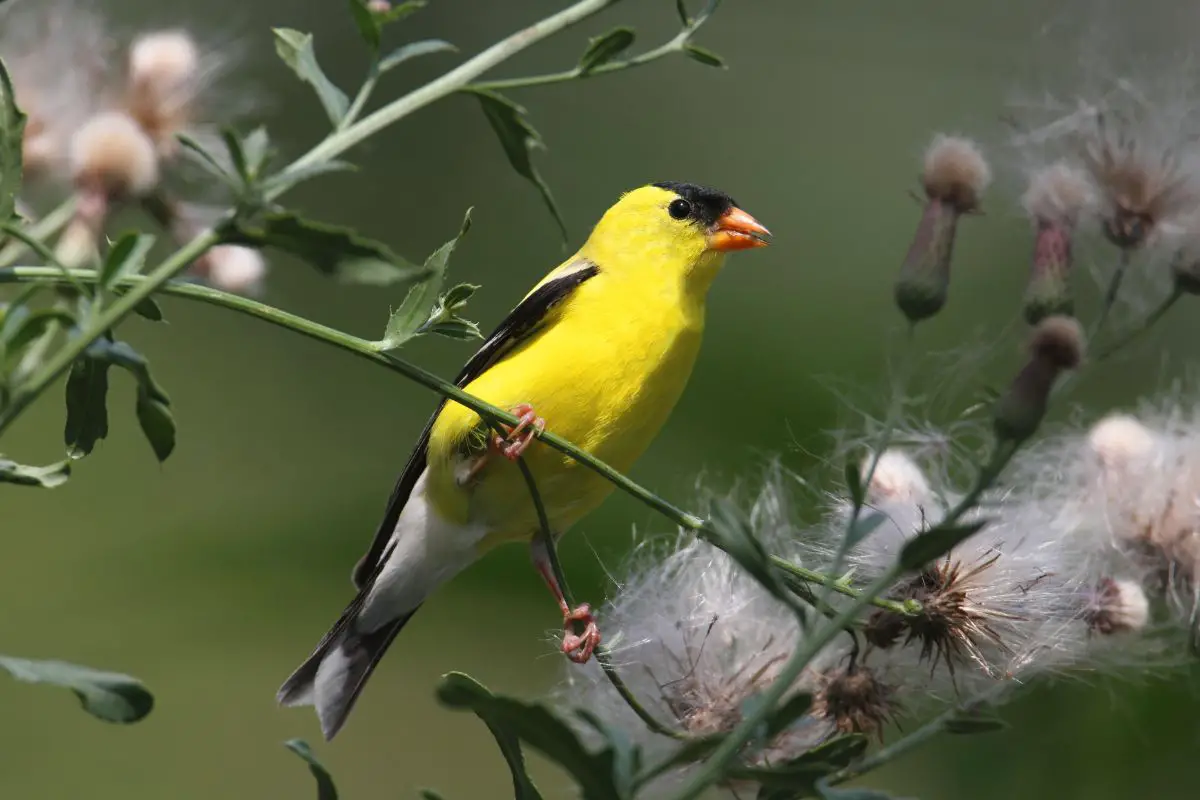
If the bird you have seen was a striking yellow and black one about 4.3 to 5.1 in. (11-13cm) long, then you were most likely looking at an American Goldfinch. They are common in patches of thistles and weeds, along roadsides, and in open woods. They also frequent semi-open and open areas with little or no trees nearby.
As is usual with most bird species, the males are prettier (sorry ladies!). They are brilliant lemon yellow with black caps and black wings. The males also have a white rump.
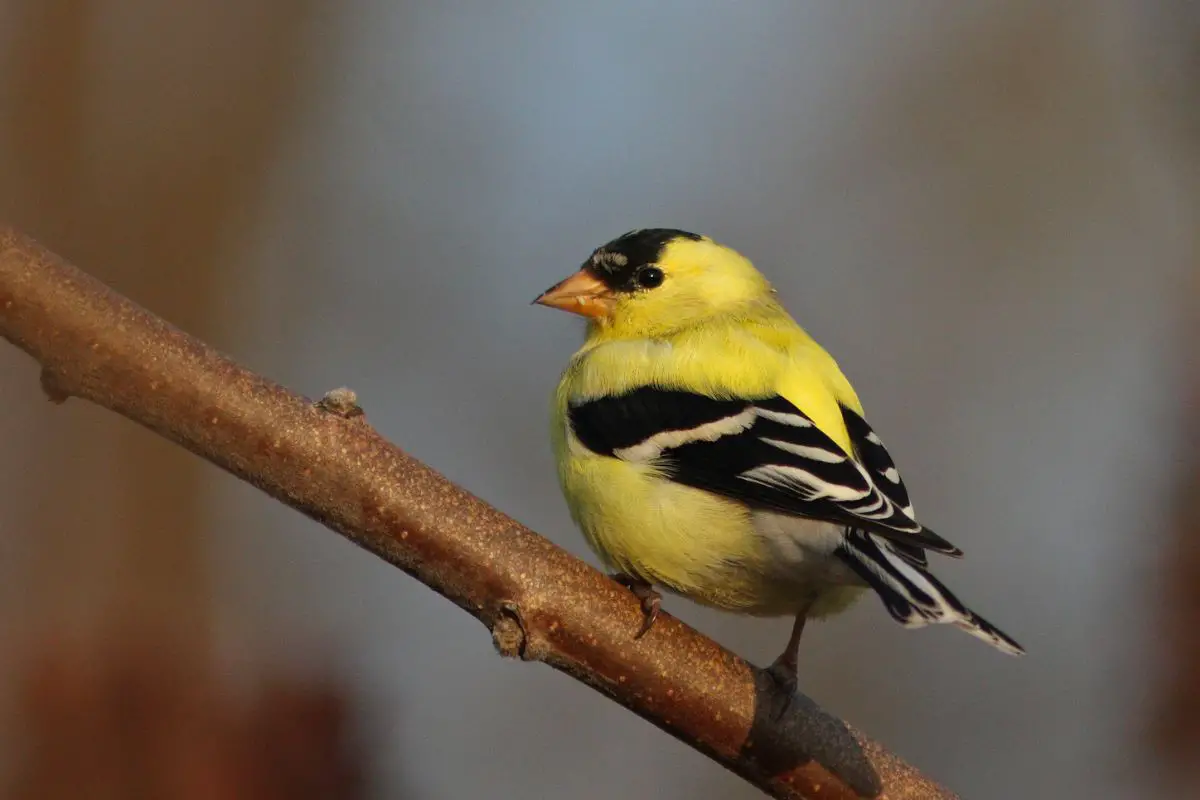
Females are mostly brown with a lighter underside and a yellow bib (the area just under the beak). Beaks in the male and female are pink for most of the year but turn bright orange in Spring.
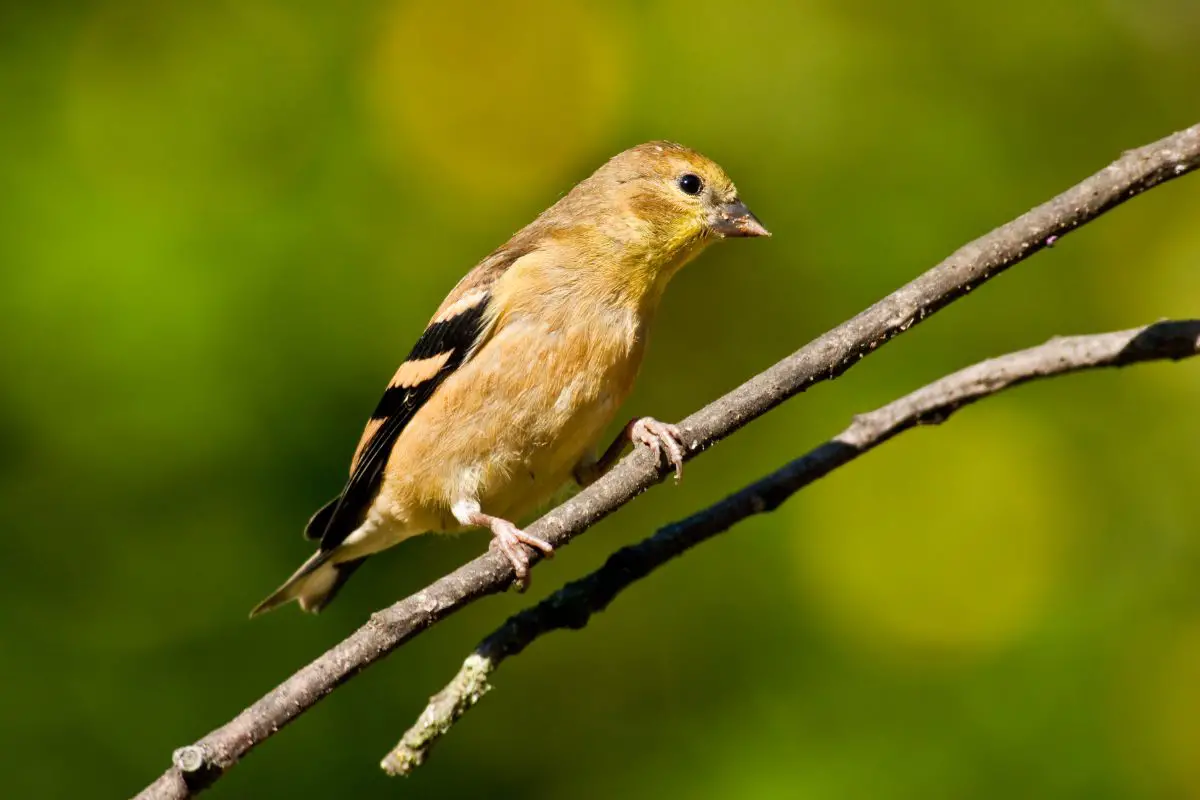
During Spring and Fall, American Goldfinches will molt. If the bird you saw was looking a little bedraggled then it may have been a molting Goldfinch like the one below:
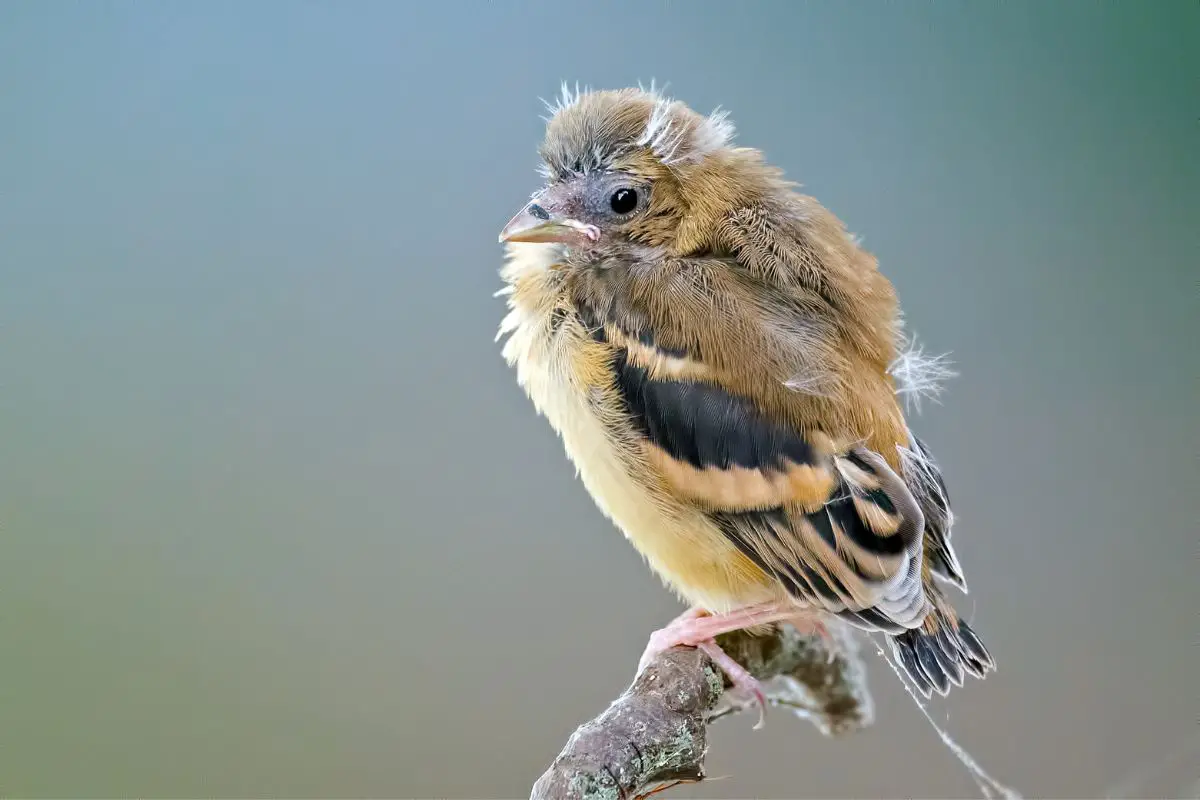
Watch the short video below from Afrtable on YouTube to see American Goldfinches in action:
What do birdwatchers need? Find out in this ultimate beginner’s guide.
5. Common Yellowthroat
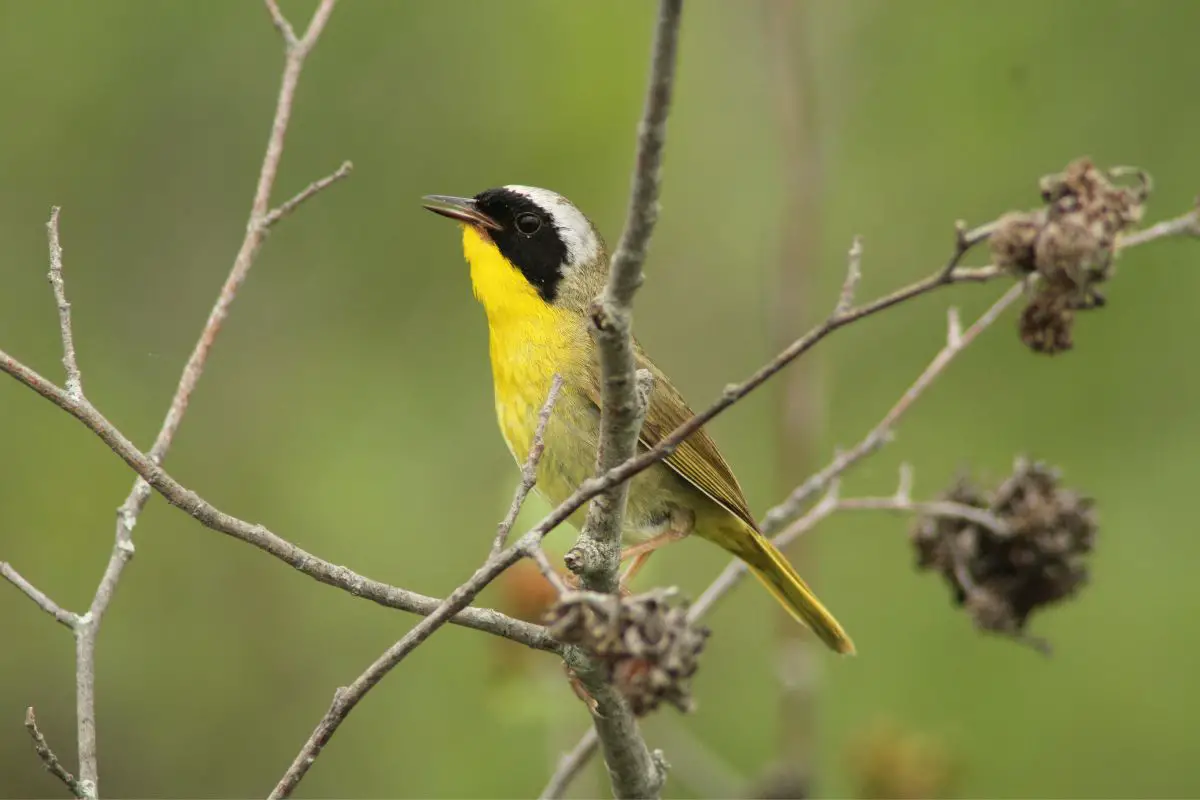
The Common Yellowthroat is a beautiful little bird around 4.3 to 5.1 in. (11-13cm) long. The males and females both have olive backs, wings, and tails; yellow throats and chests, and are white on the belly.
The adult males have that striking black mask from the beak across the eyes and down their faces, bordered above with white or gray.
Female Common Yellowthroats are similar to the males but have paler underparts and do not have the black mask. Immature birds are similar in color to adult females.
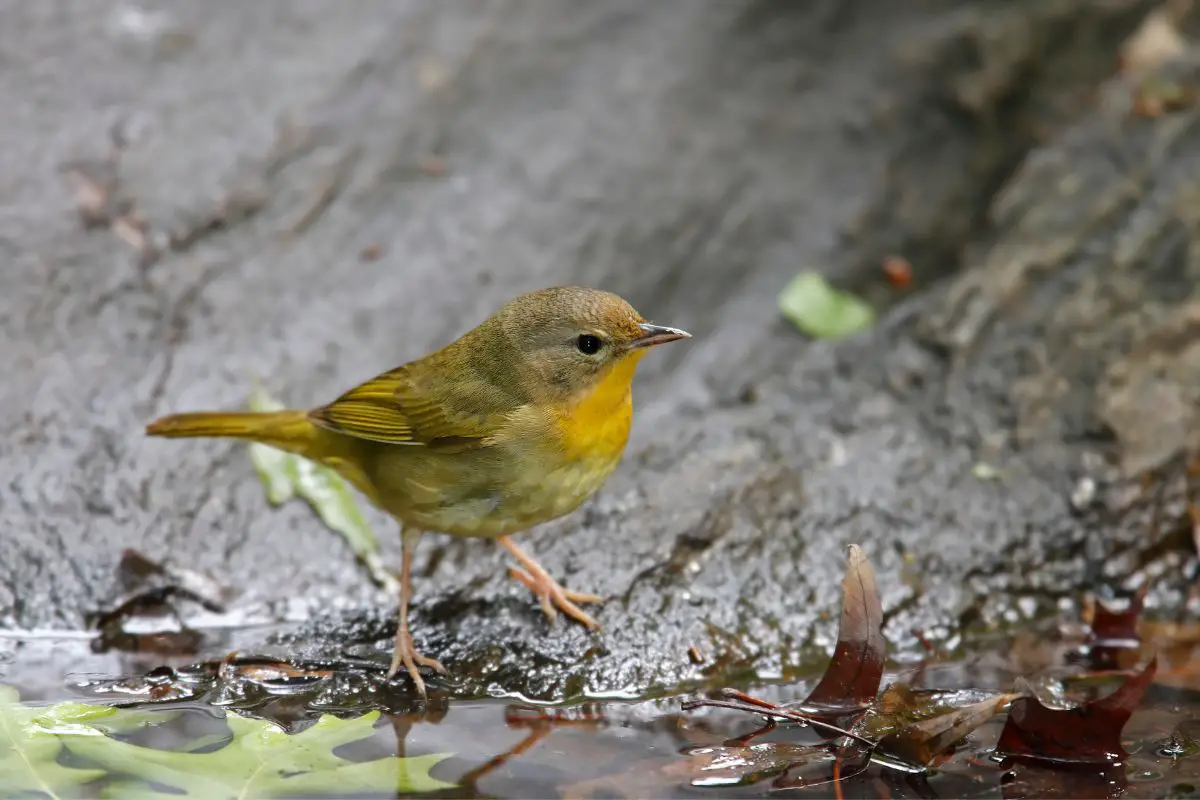
These birds are found in all regions of the United States. You can find them in practically every reed-bed from east to west as they are the only Warbler that nests in open marshlands.
The video by Garth McElroy below shows you the movements and call of the Common Yellowthroat:
6. Red-eyed Vireo
The Red-eyed Vireo is a beautiful songbird with olive-green upper parts and white underparts. On their head is a gray crown with a black edge. They also have a blackish line through their eyes and a white stripe just above this.
In the image below you can see the blue-gray legs of the Red-eyed Vireo and the yellow on their flanks and under the tail.
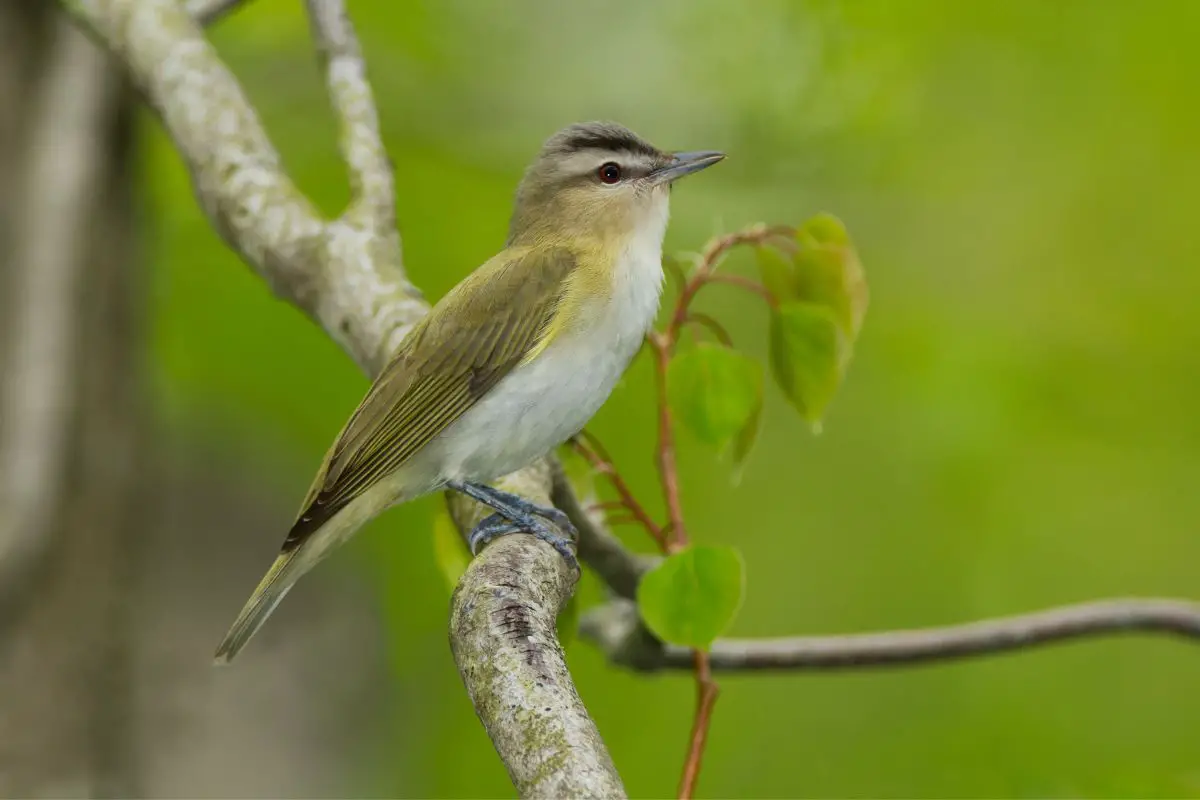
These gorgeous birds are 4.7 to 5.1 in. (12-13cm) long and spend a lot of time high in the treetops. During the nesting season and on summer nights in the eastern states, their call can be heard constantly in the woods.
If you are lucky enough to see one of these birds, it will most likely be in woodlands or groves. They can also be found in wooded suburbs, orchards, and parks.
Listen to the beautiful call of the Red-eyed Vireo in this video from Benji Beluga:
7. Indigo Bunting
These small 4.5 to 5.1 in. (12-13cm) birds are possibly the most common songbird in the eastern states. They are also found as far west as California.
The adult male is mostly cerulean blue with an indigo head during the breeding season. His wings and tail are black with cerulean blue edges.
The male plumage in fall and winter changes to having brown edges to the body and head feathers which overlap to make it seem mostly brown.
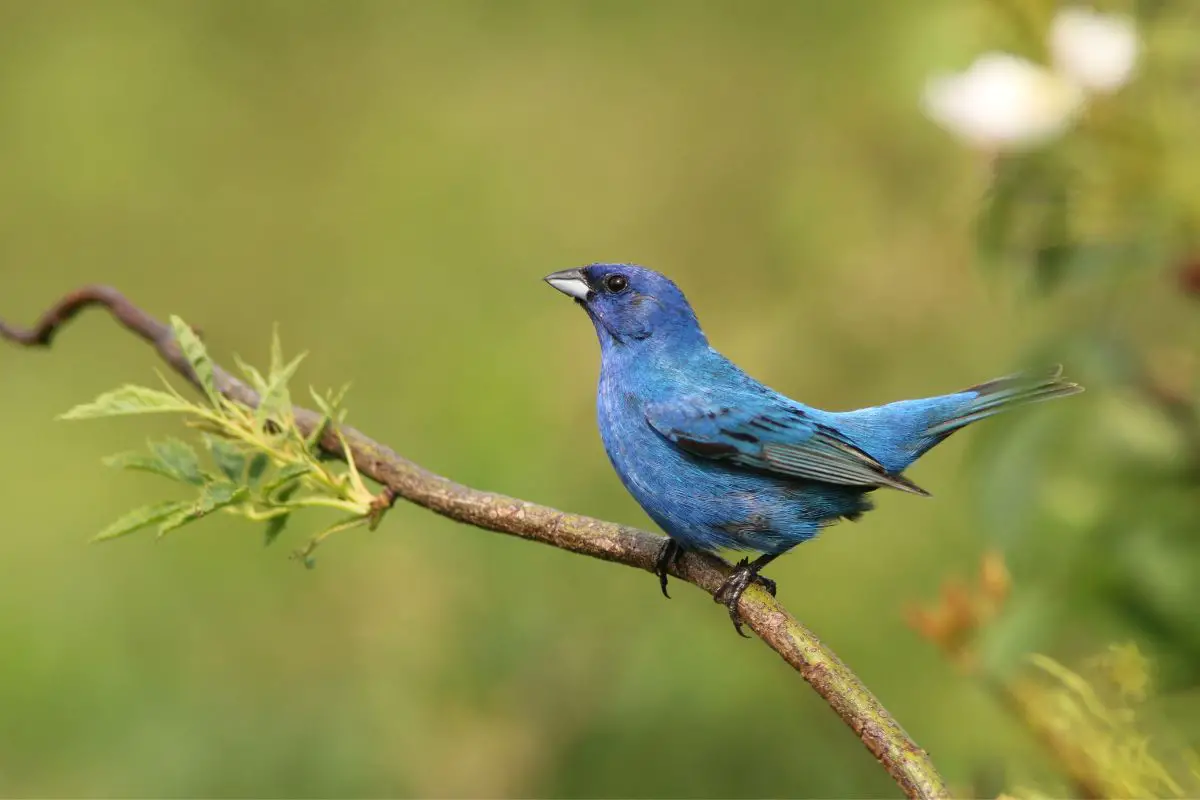
The female as seen below is brown on her upper parts and lighter brown underneath. Young Indigo Buntings resemble females in plumage.
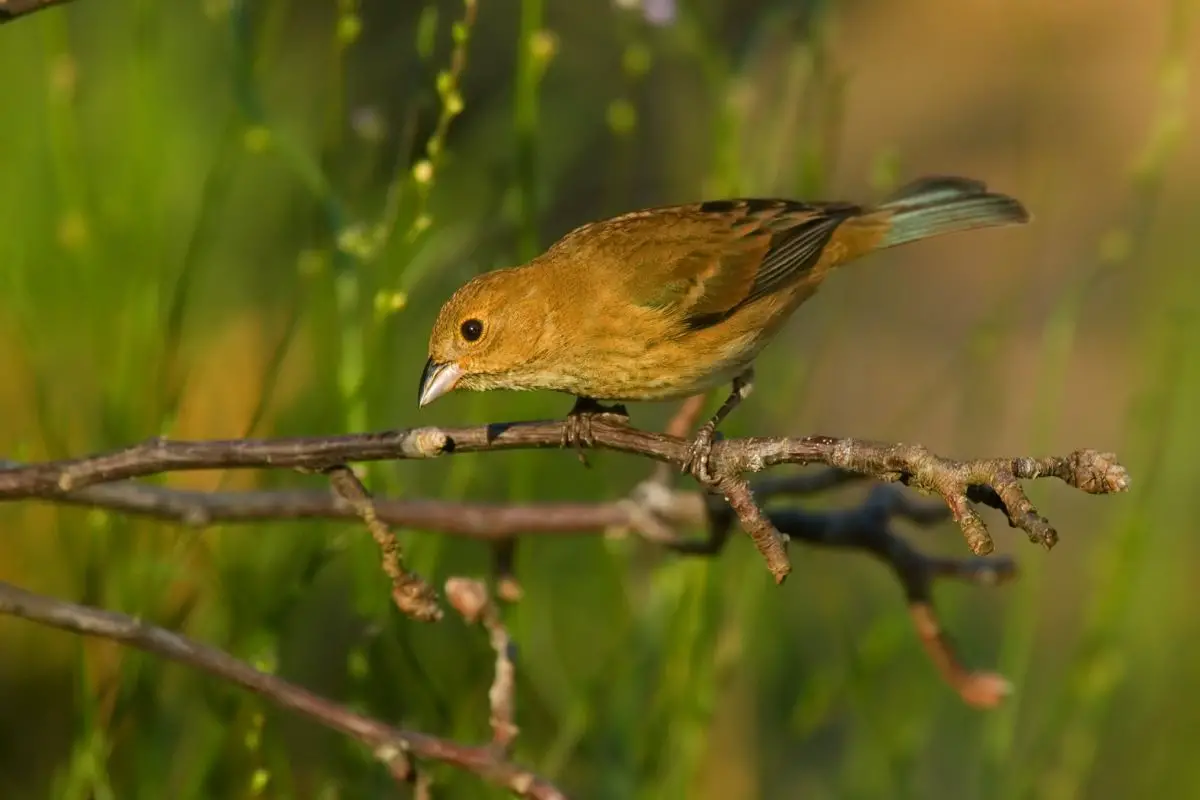
Watch the male Indigo Bunting and hear him calling in the video below from Lang Elliot:
8. Yellow-rumped Warbler
These stunning little birds are gray with patches of white on their wings. They have a yellow bib, flanks, and rump (of course!). In the winter months, they will appear pale brown with a bright yellow rump and some yellow on their flanks.
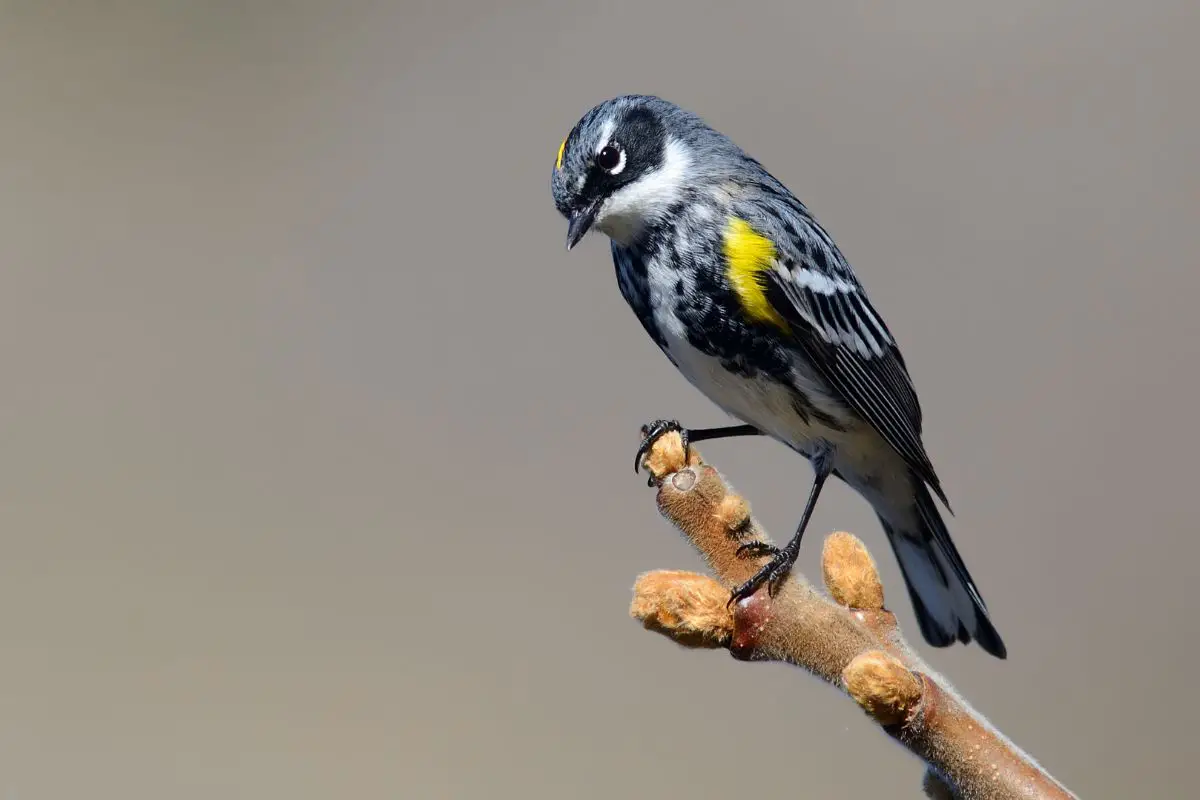
Females are duller in color and may have some brown on them.
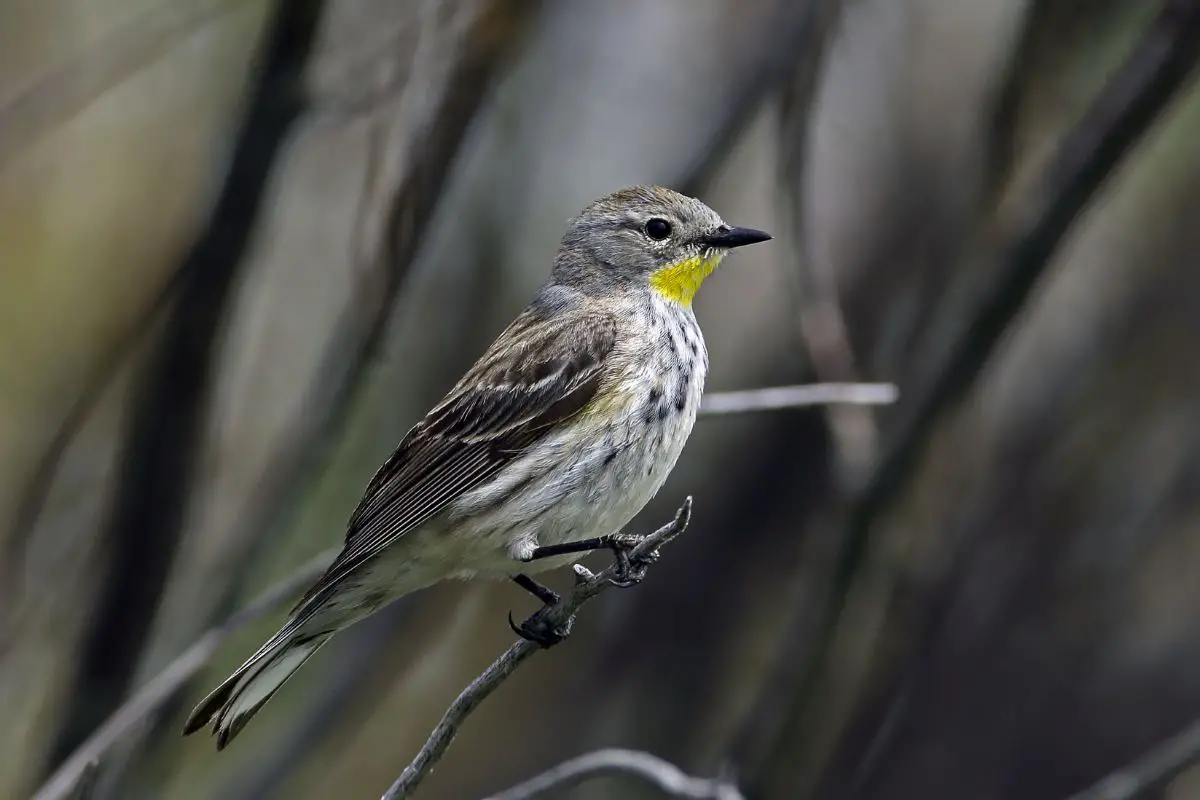
The Yellow-rumped Warbler is between 4.7 and 5.5 in. (12-14cm) long and is found all across the country. During the summer they will be found in coniferous forests and sometimes deciduous forests. In fall and winter, they can be seen in open woods and shrubby areas, in coastal vegetation, in parks, and in residential areas.
This video by Garth McElroy shows the Yellow-rumped Warbler calling:
9. Carolina Wren
One of 11 species of Wren in the United States, the Carolina Wren has a chestnut belly, brown wings with spots, a dark brown tail, a brown cap with a light brown supercilium (area above the eye), and slightly darker brown cheeks. The bib is light brown.
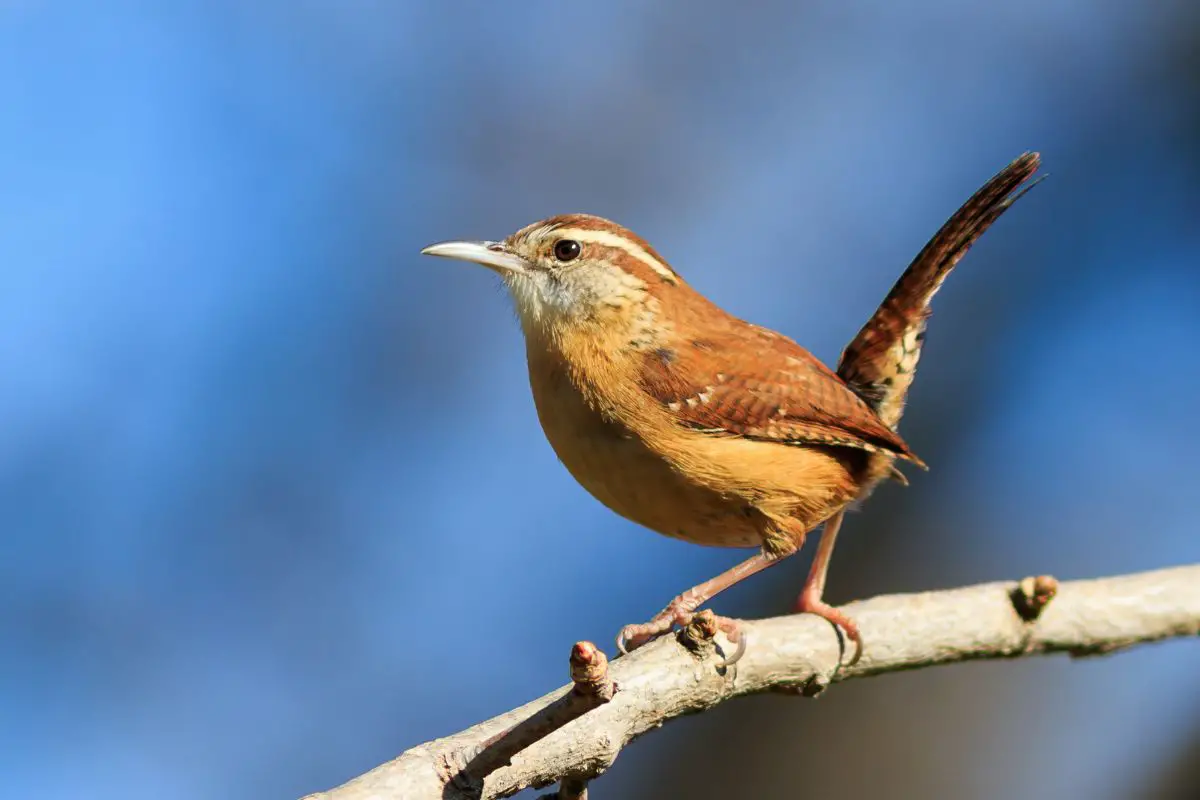
There are 7 subspecies of this Wren across their range and they all look slightly different and have different songs.
Carolina Wrens are found mostly in the southeastern states and up into the northeast. They prefer the dense cover of tangles and undergrowth and rarely venture beyond the safety of cover for long periods.
When they do come out from cover they will hardly stay still, constantly hopping about looking for food.
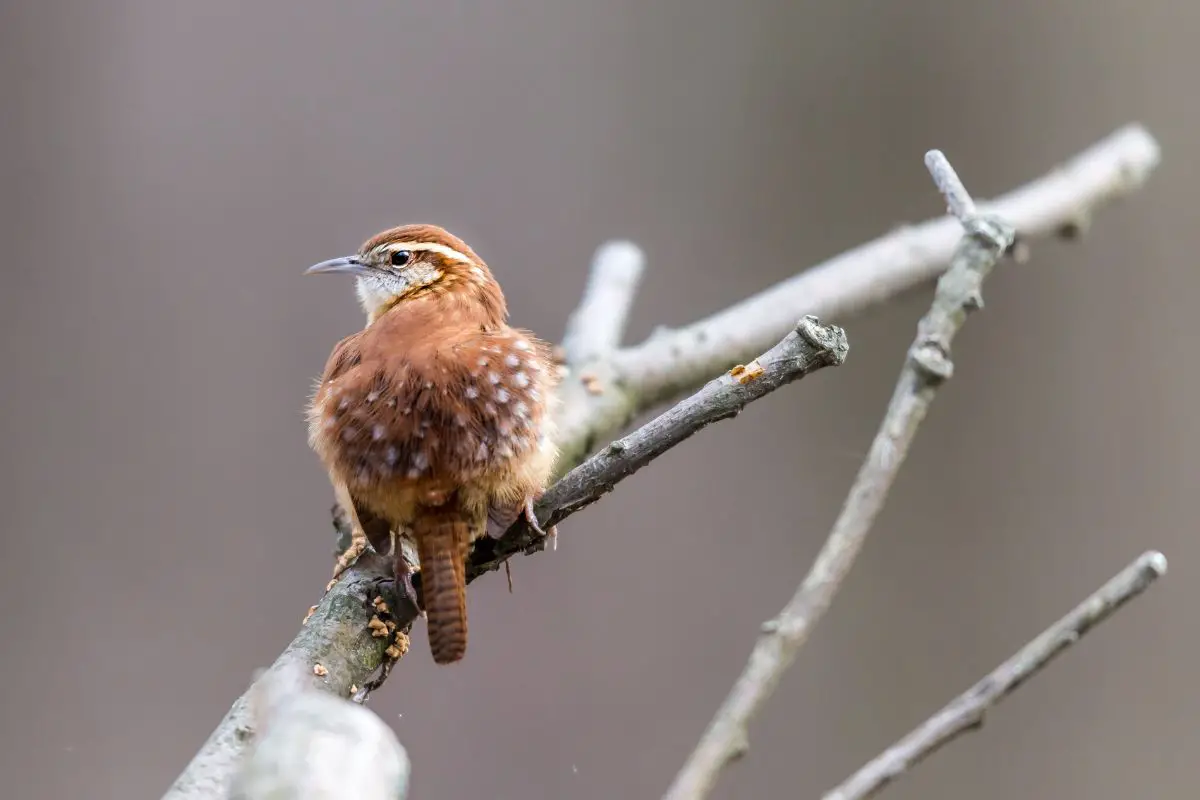
Carolina Wrens can be anywhere between 4.7 to 5.5 inches (12-14cm) long with males being slightly larger than females.
Watch the swift movements of this little wren and hear its call in this video from Mark Vance of Sarasota, Florida:
10. Common Redpoll
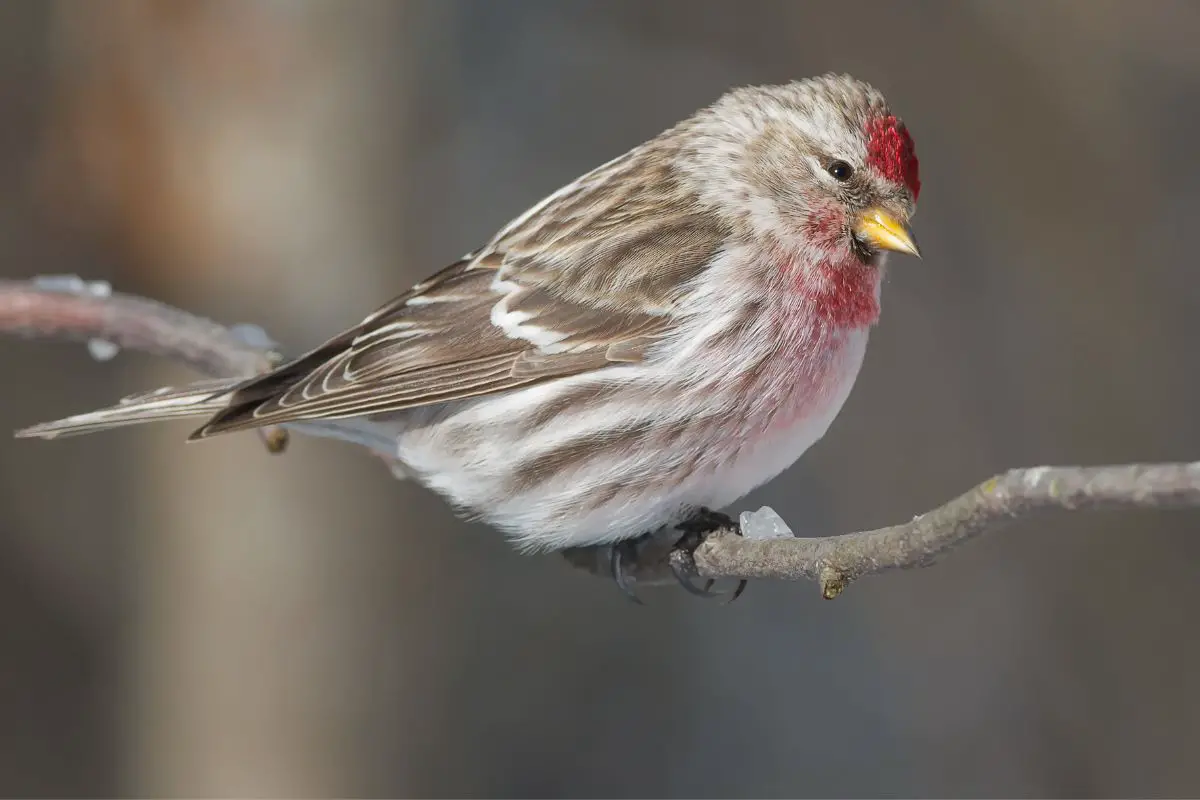
A stout-looking brownish-gray bird with dark streaks and a distinctive red patch on its forehead. The Common Redpoll is a Finch found in the northern states. They nest in the Arctic and do not venture too far south.
Males have pale red on the upper chest and flanks. Both males and females have black bibs and pale stripes on their wings.
Common Redpolls are between 4.7 and 5.5 in. (12-14cm) in length. You will likely find them in willow flats, open conifer forests, and fields with lots of weeds. They will visit backyard feeders in the winter.
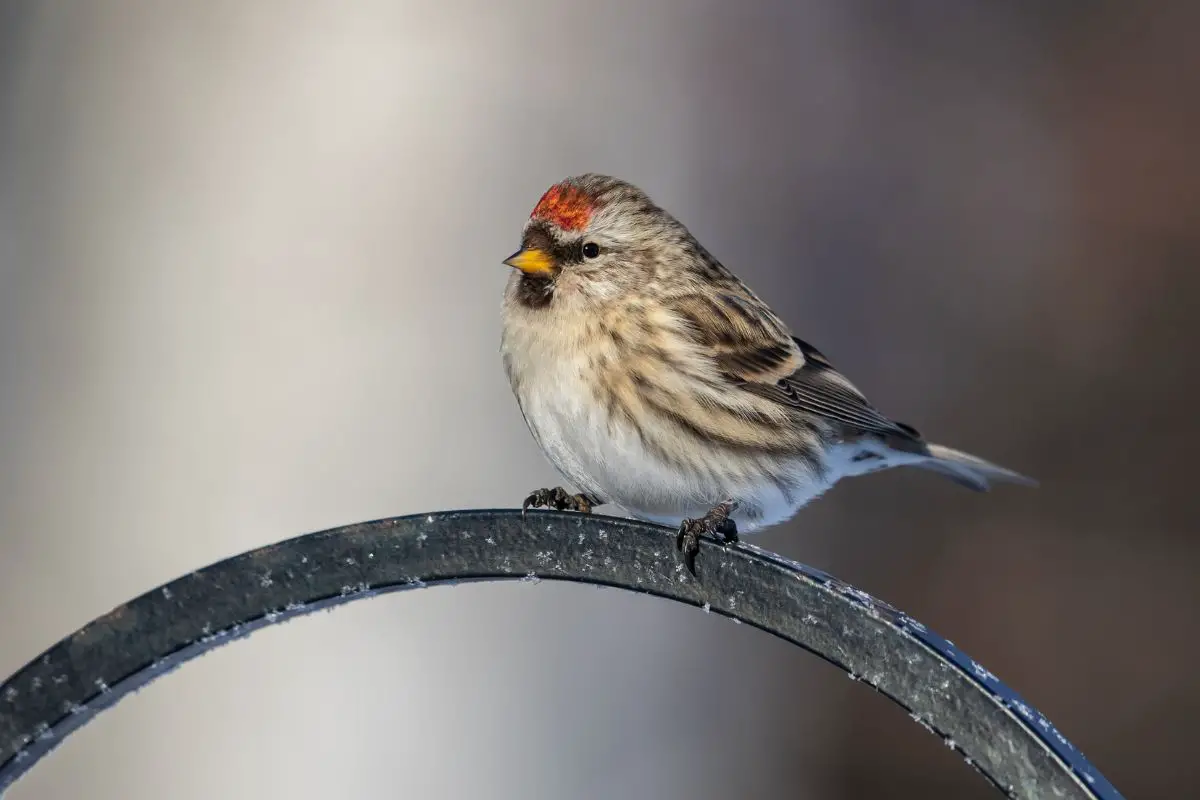
Hear the call of the Common Redpoll in the video below by ToToWildlife:
11. Black-capped Chickadee

Sound the cute alarm?!? The Chickadees are back!
The Black-capped Chickadee, while a tiny bit bigger than the Carolina Chickadee at between 4.7 and 5.9 inches (12-15cm), is just as cute.
Black-capped Chickadees have a black cap and bib and a white strip across their faces below the eye. Their bellies are white with rusty-colored flanks, they have gray wings and back, and a slate-gray tail. The outer edges of their tails are more broadly edged with white than that of the Carolina Chickadee.
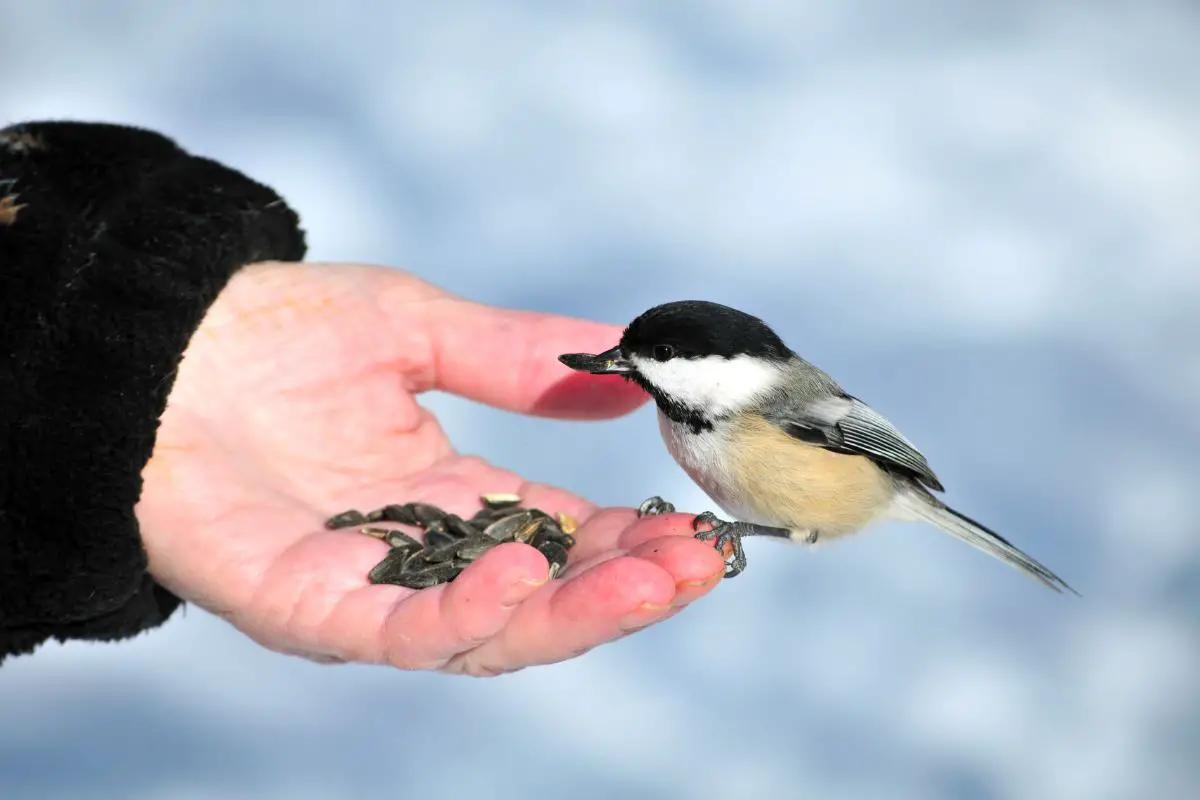
Small flocks of these little birds delight people across the northern United States in all seasons. They are regular visitors to bird feeders also and love sunflower seeds.
Black-caps are most common in open woods and forest edges, especially where they can find a nice birch or alder.
Watch these cute little puffballs and hear that “chickadee dee dee” call in this short video from LesleytheBirdNerd:
12. Chipping Sparrow
The second type of Sparrow we’re looking at here is the Chipping Sparrow. These gray and orangish-rust-colored birds are 4.7 to 5.9 inches (12-15cm) long. Their plumage varies throughout the year depending on whether or not they are breeding.
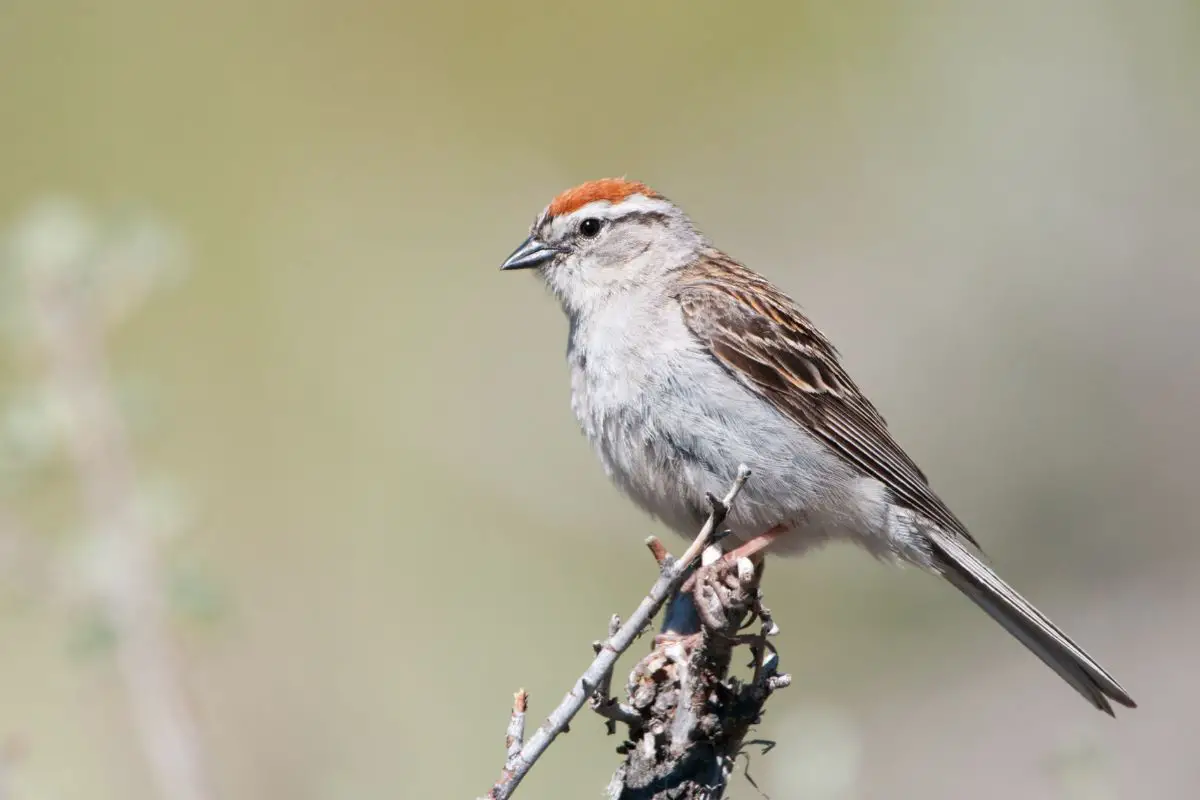
As you can see in the image above, when breeding, the adults will have a reddish cap, a white area above the eye, and a black eye line. The image below shows a bird in non-breeding plumage, note the brownish cap, dusky supercilium (area above the eye), and dark eye line (not black):
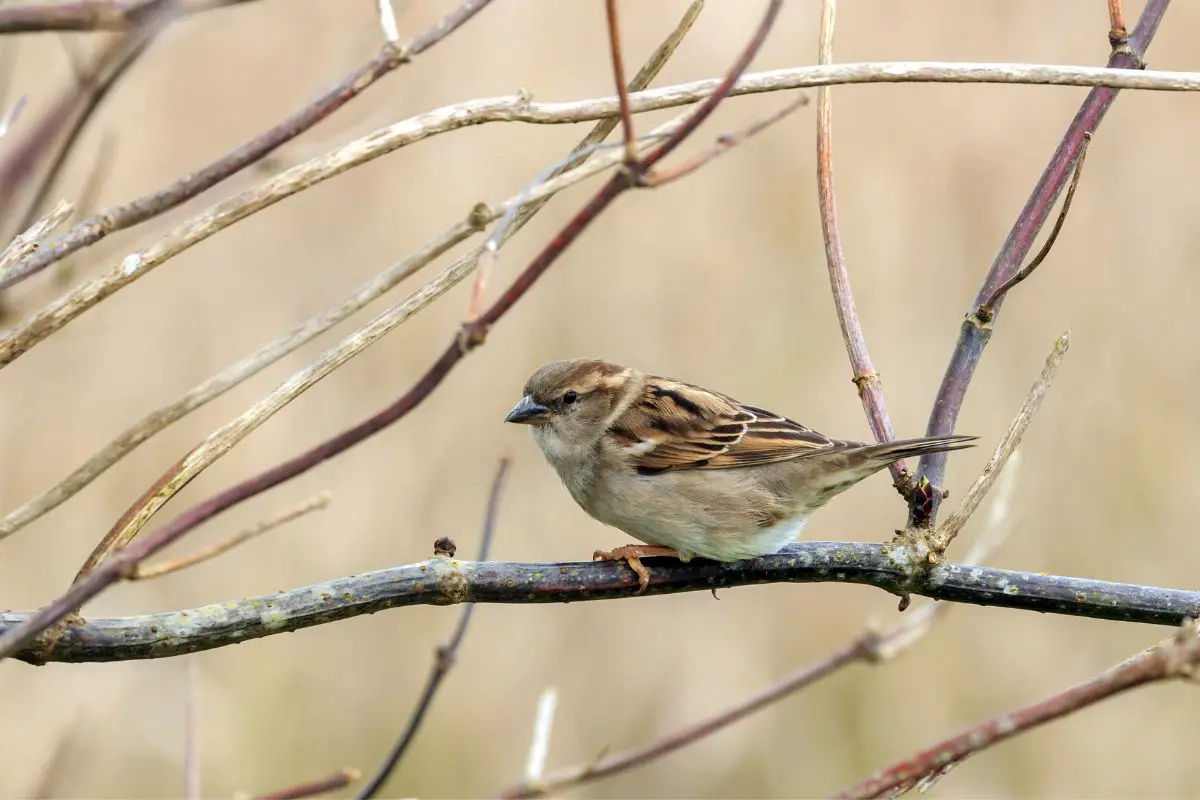
These birds are widespread over much of the United States. They like open woods, conifers, and orchards. They are very tame birds and will frequent farms and towns.
View some Chipping Sparrows in the video below from Garth McElroy:
13. Tree Swallow
Another bird species that are numerous in America are Swallow. There are 7 different types of Swallow listed on audubon.org and each has a very different coloration though they are all similar in body shape.
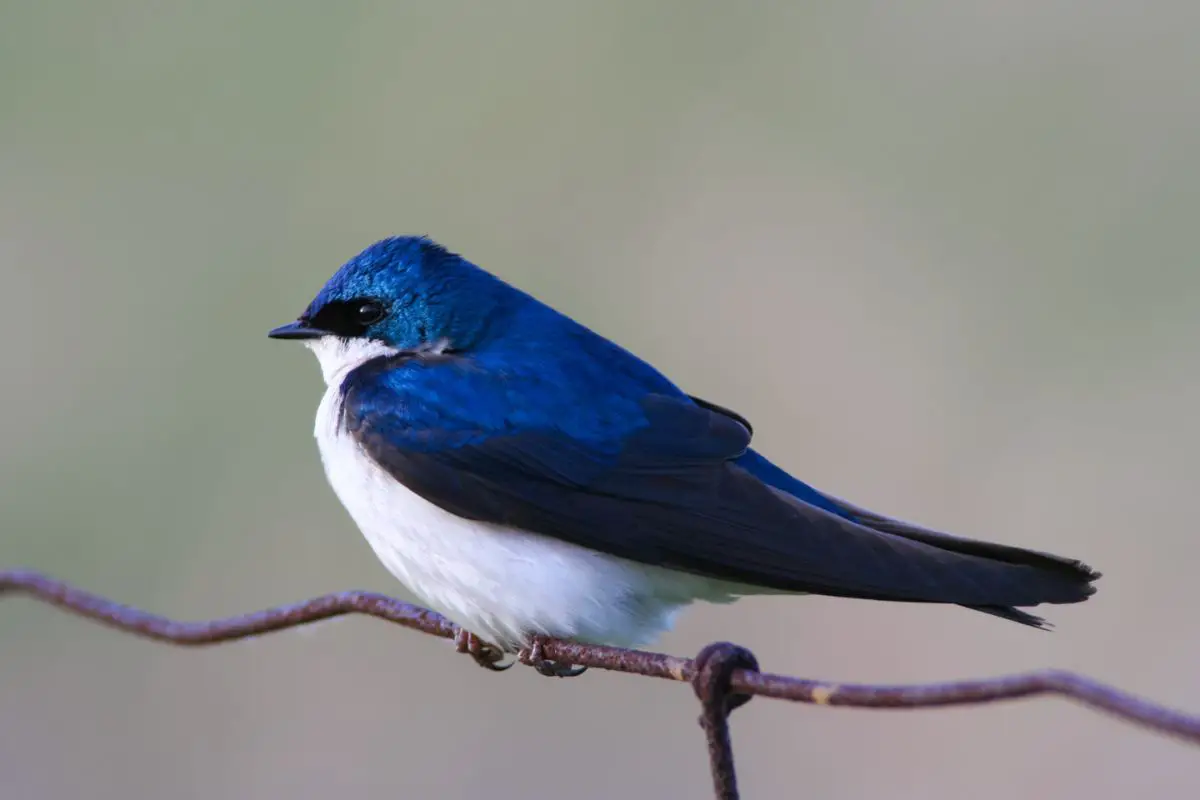
Between 4.7 and 5.9 inches (12-15cm) long, the Tree Swallow is common all across the United States. The male is mostly glossy blue-green above and white underneath. His wings and tail are both black.
The female is a little duller in color than the male and often has a brown forehead.
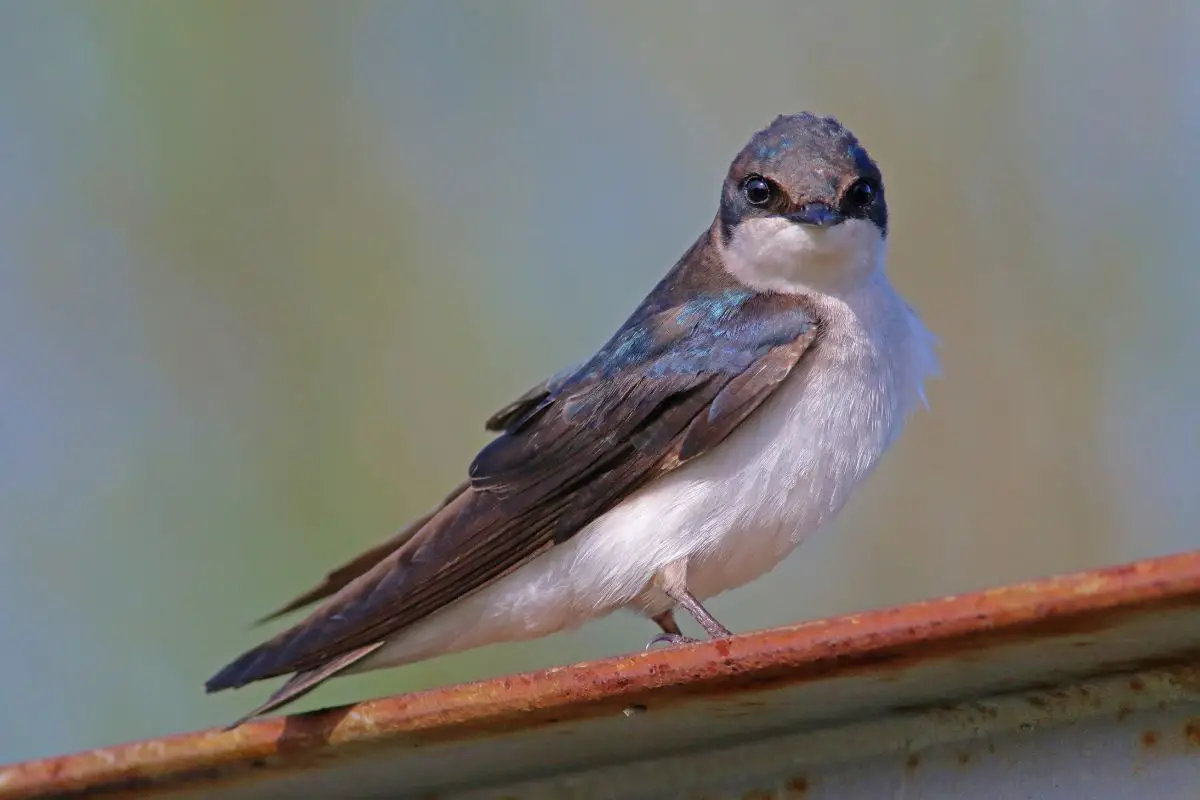
Tree Swallows prefer open country near water, marshes, meadows, or lakes. They sometimes nest away from water in brushy areas or meadows.
Learn more about Tree Swallows and watch their skillful flying in this video from Dominique Lalonde Films Nature:
14. Song Sparrow
Audubon.org recognizes 38 different species of Sparrow in North America and they are commonly called “little brown jobs” by serious birders. If you’ve seen a little brown bird, it might have been a Sparrow. We’re going to explore just 2 of the 38 species here in this post and the first is the Song Sparrow.
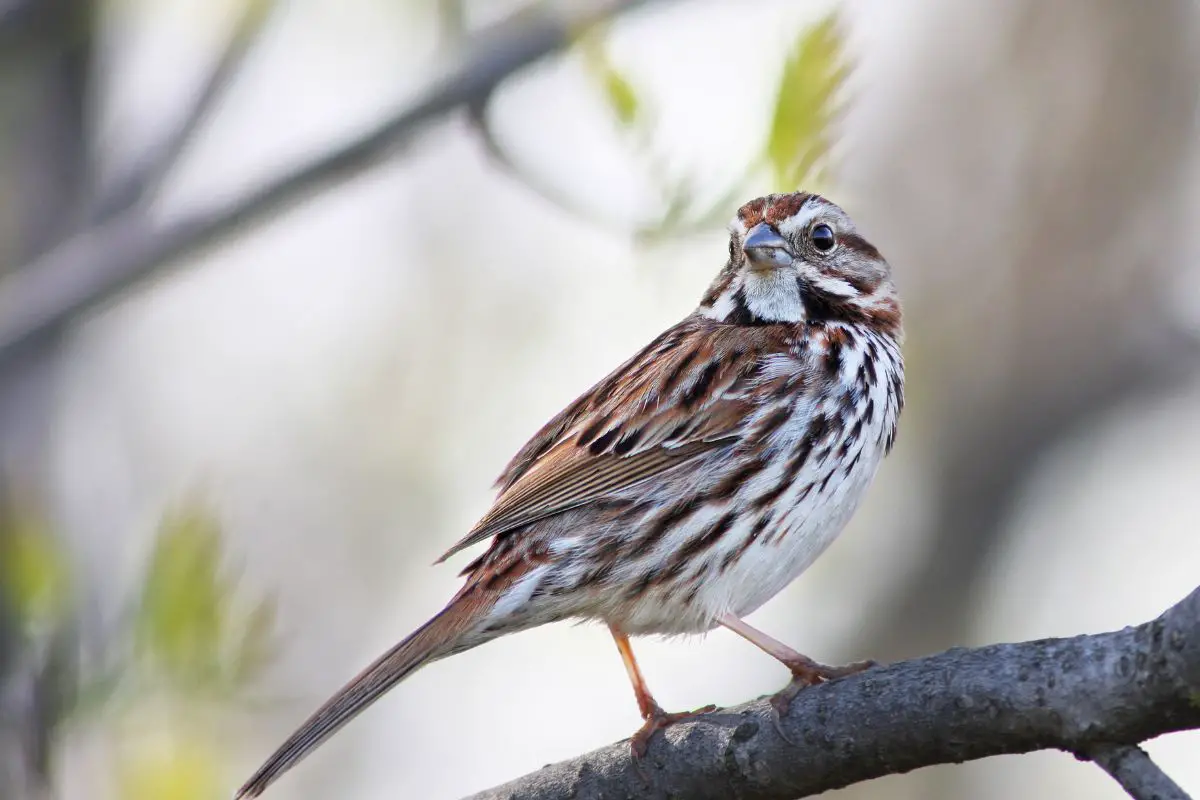
Adult Song Sparrows are brown with dark streaks on their wings and backs and have white bellies with dark streaks also. They have a brown cap and their faces are gray with a brown streak across each eye.
These birds are very common throughout all states and are very familiar birds in the Northeast and Midwest. Their appearance varies across their wide range with around 52 forms having been identified by scientists.
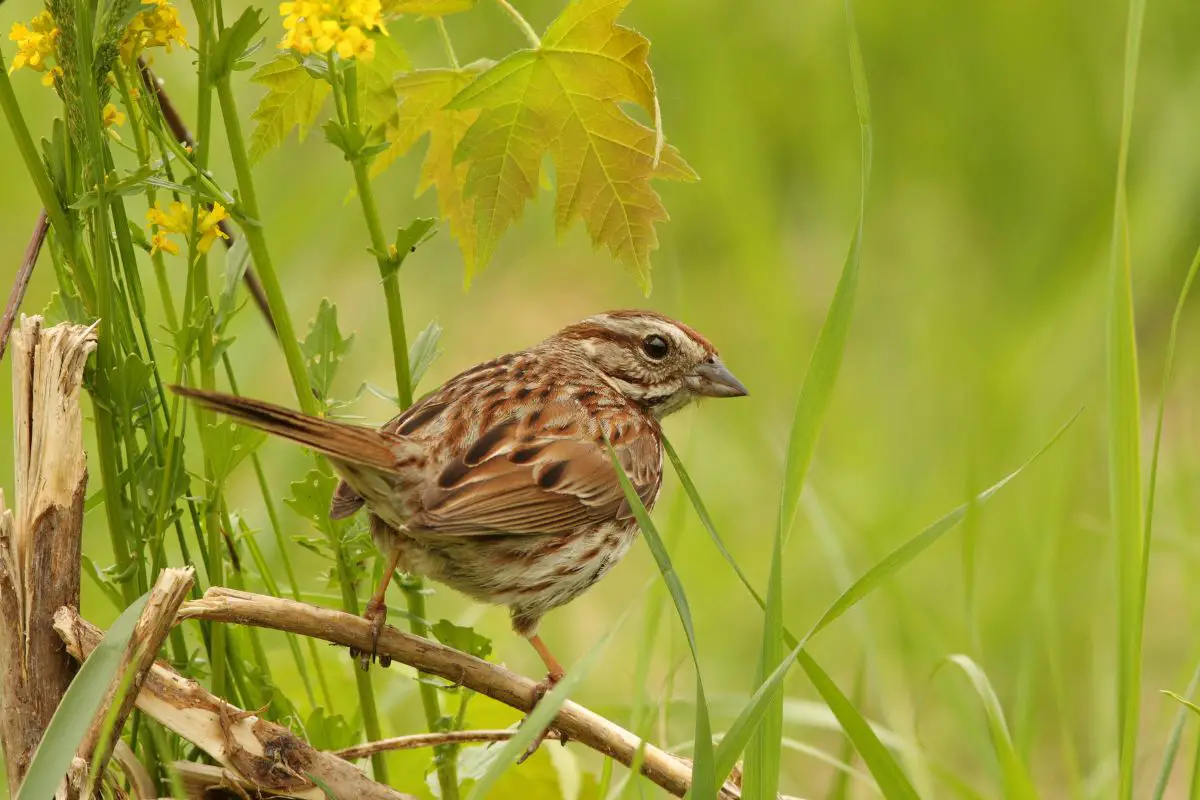
Mostly they can be found in brushy fields, alongside streams and marshes, woodland edges, hedgerows, and lush gardens.
Watch these 4.7 to 6.7 in. (12-17cm) little songsters in the video below from Lang Elliot:
15. White-breasted Nuthatch
Our small birds are starting to get just a little bit bigger with the White-breasted Nuthatch which measures between 5.1 and 5.5 inches (13-14cm) long.
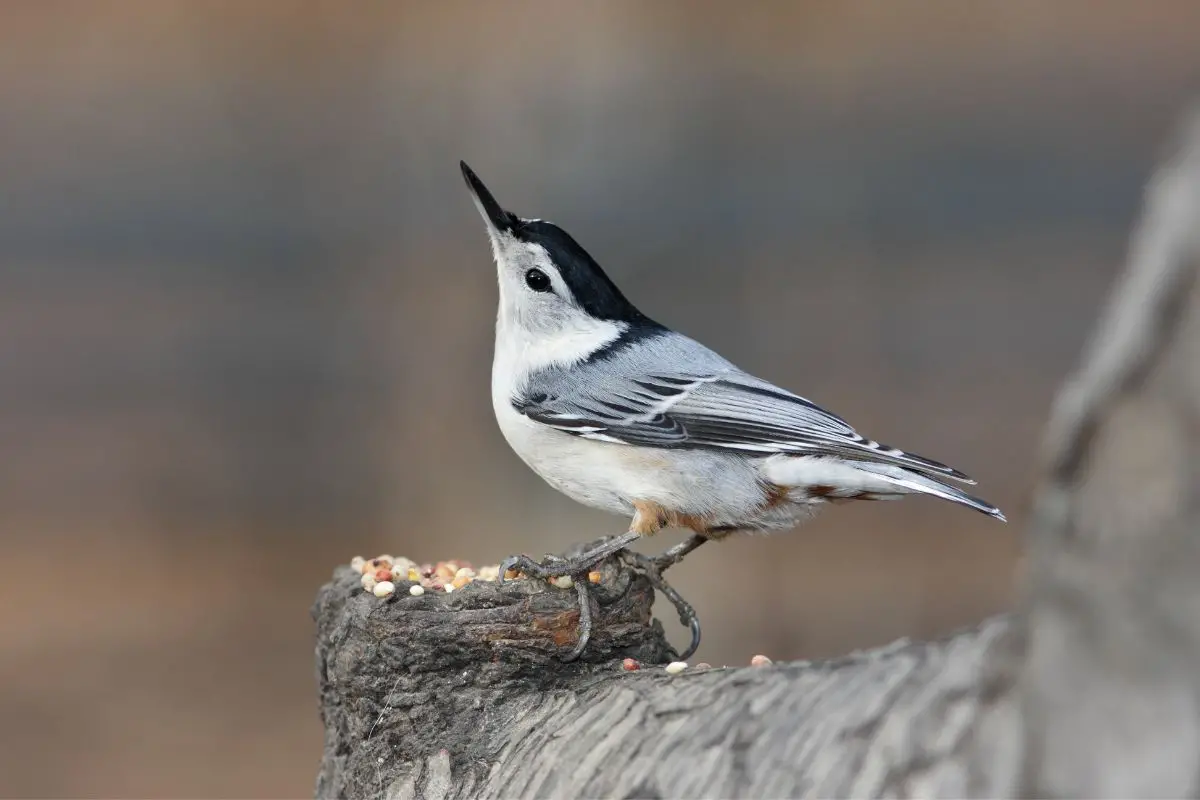
The male White-breasted Nuthatch is grey-blue on the back, snow-white on the face and underneath, and has a black hood. The lower belly and underside of the tail are often chestnut.
The female is very similar in coloring to the male. She may have a gray hood however, many females have black hoods and can’t be distinguished from the males. Her underparts will be slightly duller and the chestnut areas on her belly and under her tail may be softer.
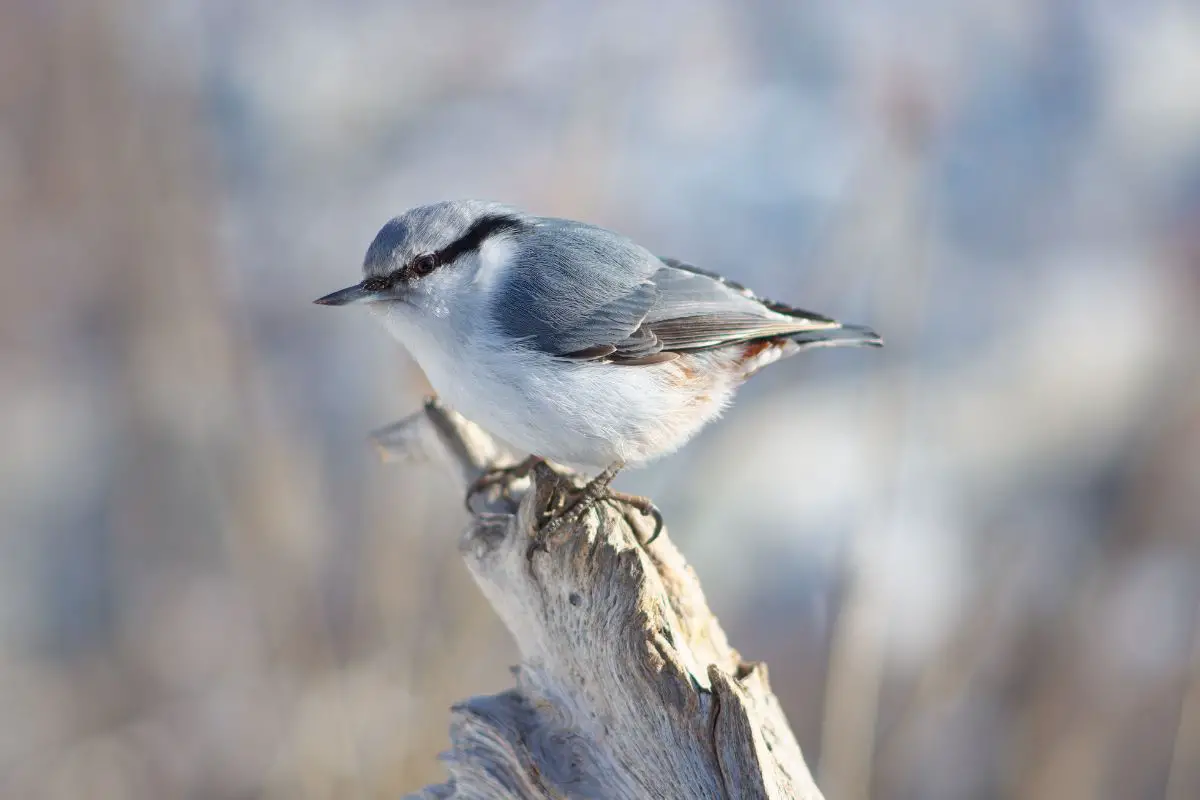
White-breasted Nuthatches like mature woods and woodland edges. You are more likely to find them hanging around maple, hickory, basswood, or oak, though they can be found in coniferous forests also.
Watch their amazing foraging and feeding behavior in this video from Dominique Lalonde Films Nature:
They are often mistaken for Woodpeckers because of the way they “hammer” at the tree bark with their beaks. Woodpeckers don’t do this upside down so if you see a bird hammering away while inverted – it’s probably a White-breasted Nuthatch.
16. House Finch
This small bird is common across almost all of North America. 5.1 to 5.5 in. (13-14cm) in length with a long, square-tipped brown tail, brown or dull brown across the back, and deep gray on the wing feathers. Their breast and belly are streaked and the adult males have reddish heads, necks, and shoulders.
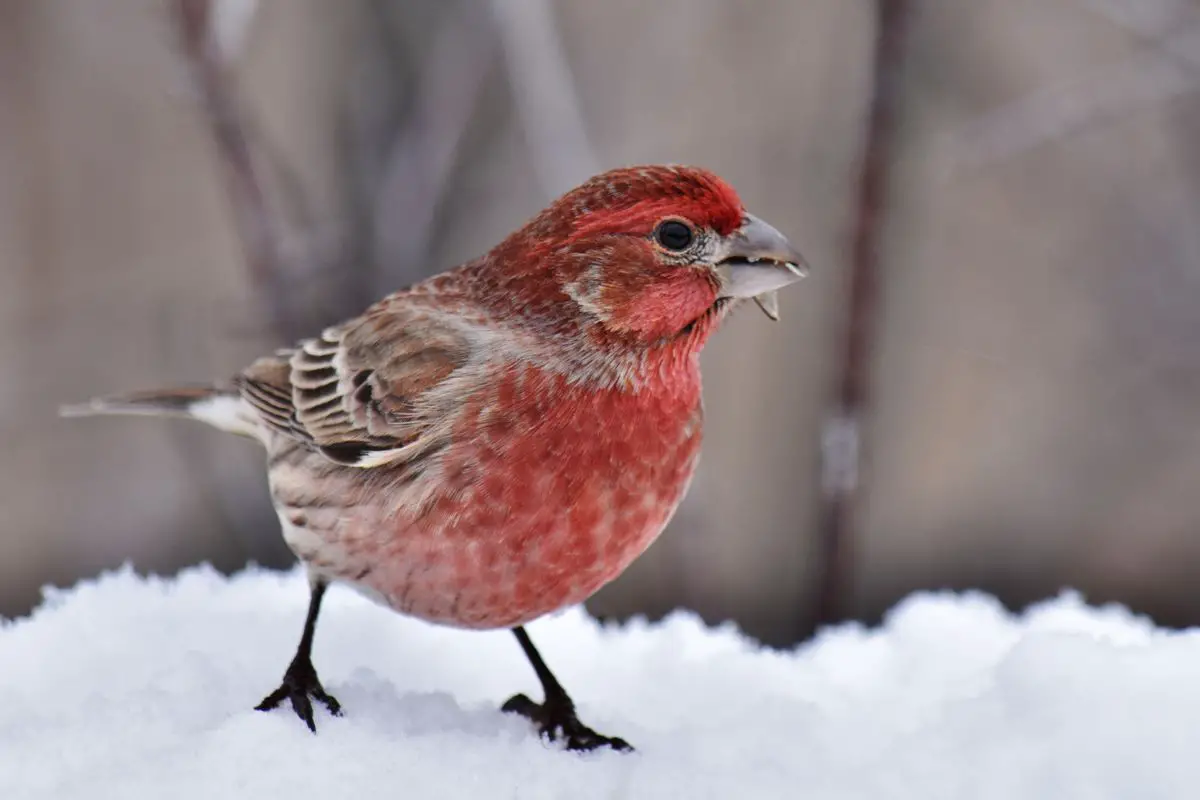
Females are mostly shades of brown and do not have the reddish areas that males have. The intensity of the red coloring of the males varies with the seasons.
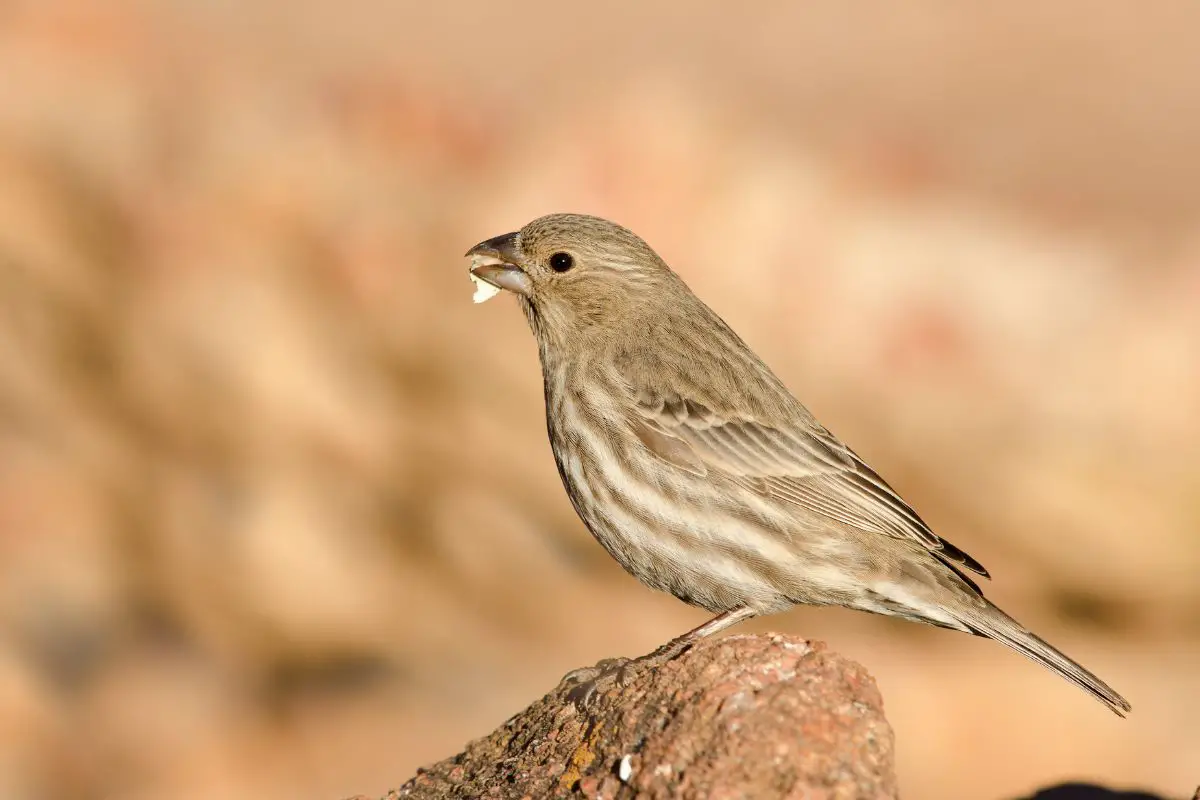
These small birds favor areas associated with humans and can be found in cities, towns, and farmland. They love lawns, weedy areas, trees, and buildings.
Watch a House Finch in action in the video below from MyBackyardBirding on YouTube:
17. Blackpoll Warbler
The Blackpoll Warbler is found in the eastern states and is a small mostly black and white bird. Breeding males have a black cap, white cheeks, and a black mustache stripe.
Both the males and females have orange-yellow legs and two white wing bars.
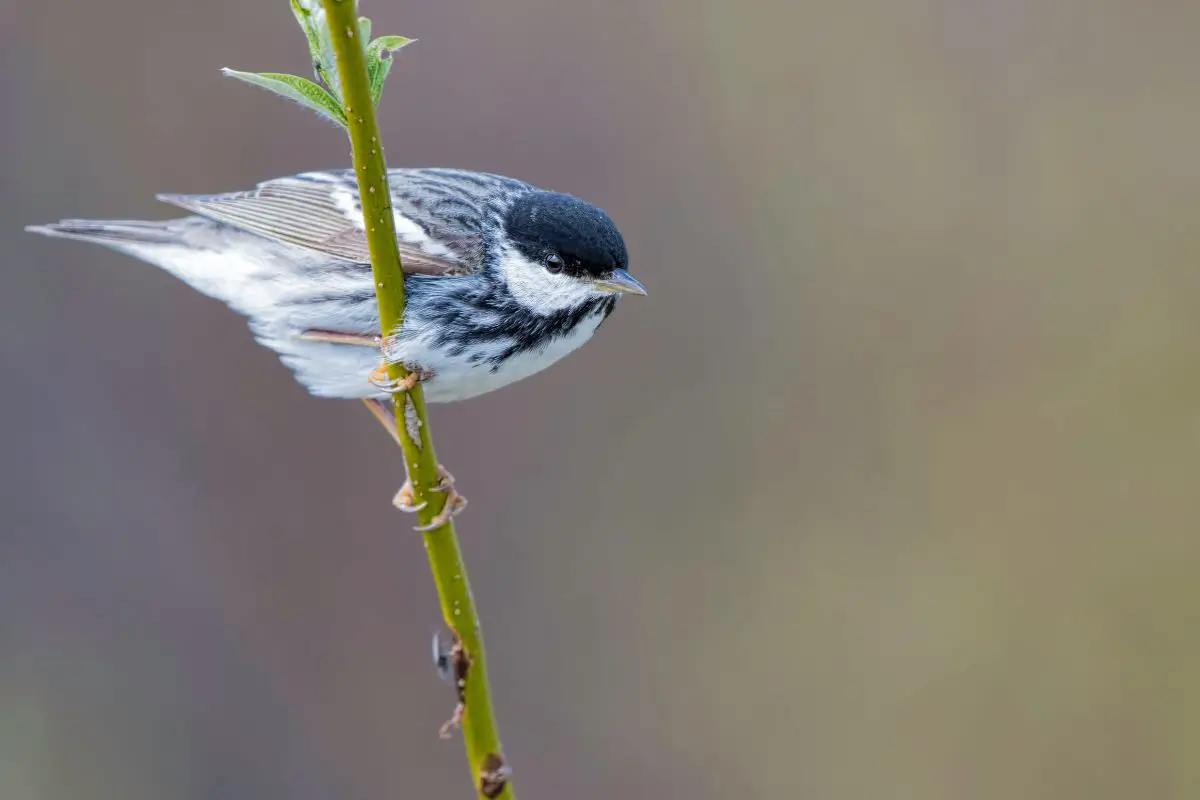
Breeding females are streaks of black, white, and gray, without black caps and white cheeks like males.
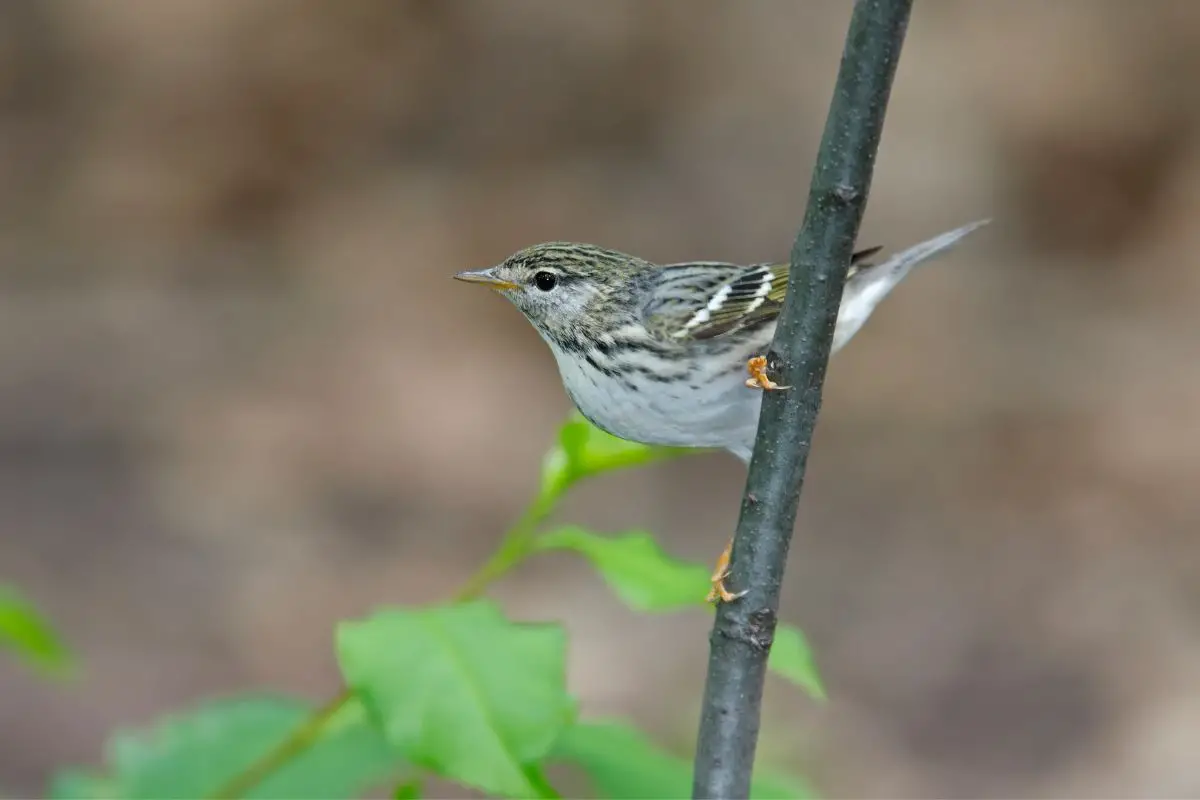
Blackpoll Warblers are 5.5 inches (14cm) in length. They breed in spruce and tamarack forests in Canada’s boreal forests and sometimes in young evergreens, alder, or willow.
During their migration, they can be found in evergreen and deciduous forests.
Watch several Blackpoll Warblers enjoying the trees of Central Park in this video from AdrianB:
18. Dark-eyed Junco
These gorgeous little birds can be found all across North America. Their coloring varies but generally, they are dark gray or brown with a pink beak and white outer tail feathers. Males tend to have darker and more distinct markings than females.
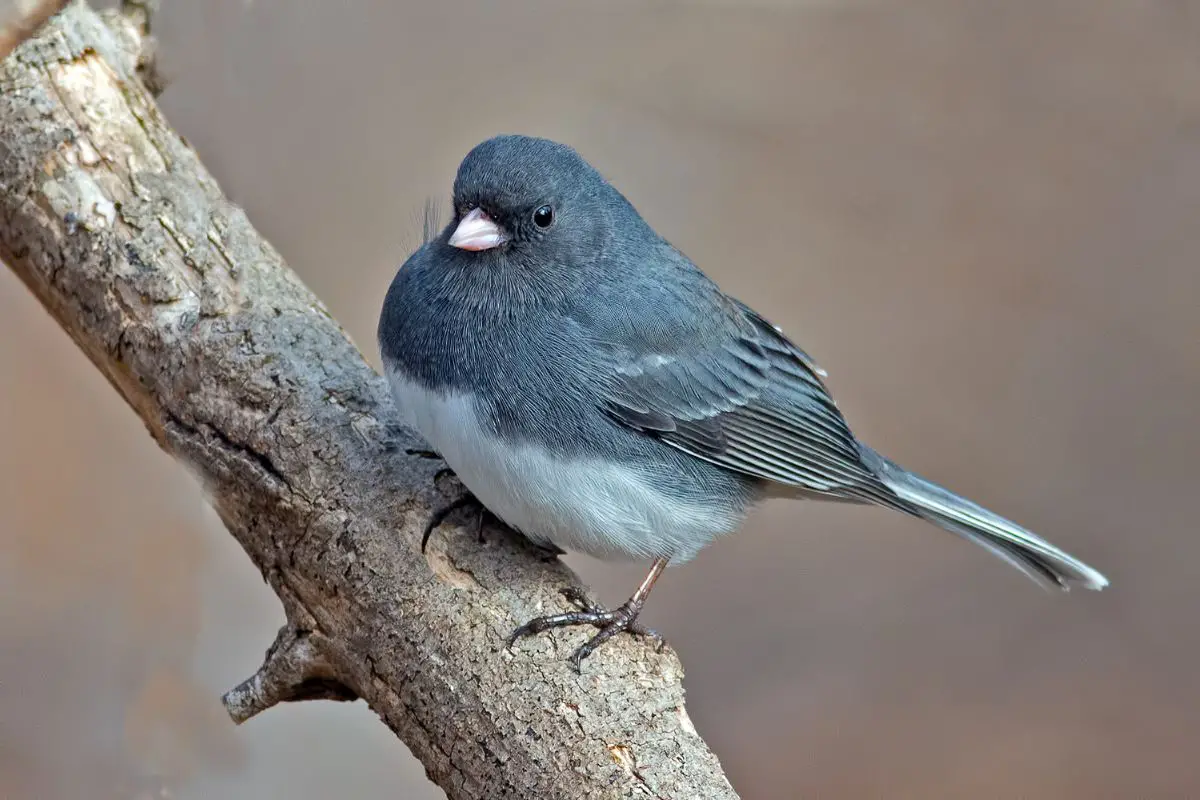
Dark-eyed Juncos are between 5.5 and 6.3 inches (14-16cm) in length. They breed in coniferous forests across Canada, the Western U.S., and the Appalachian Mountains. In the winter you will find them in open woodlands, fields, parks, roadsides, and even in your backyard.
The video below from MyBackyardBirding on YouTube shows two Dark-eyed Juncos having a “sing-off”:
19. Tufted Titmouse
This little cutie is 5.5 to 6.3 inches (14-16cm) long and is found in the eastern states. They have silvery-gray upper parts and are white underneath with a rusty or peach-colored area on the flanks.
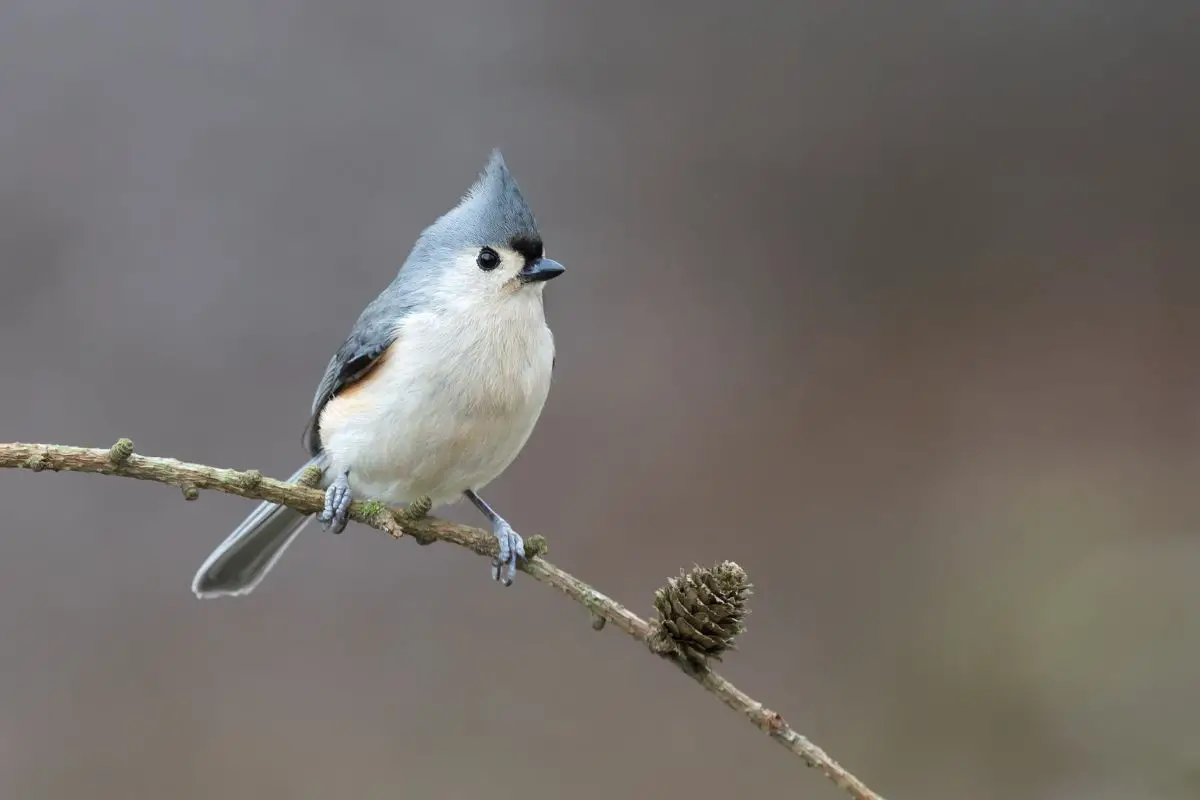
The stand-out features of the Tufted Titmouse are its black patch above the beak and its beautiful crest.
Tufted Titmice can be found in most eastern woodlands below 2000 feet. They will frequent deciduous and evergreen forests. They often visit feeders and will flock with chickadees, nuthatches, and woodpeckers.
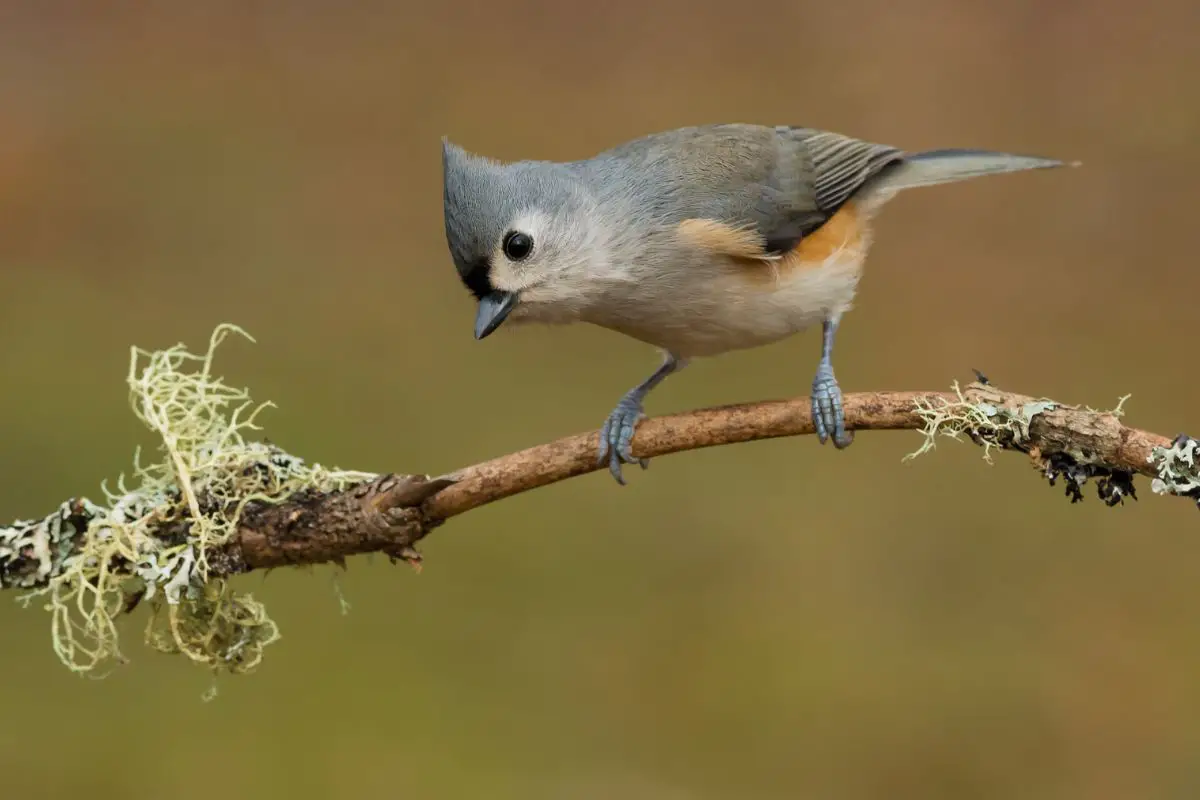
20. Downy Woodpecker
The last bird on our list is the Downy Woodpecker. This is the smallest woodpecker in the United States at 5.5 to 6.7 inches (14-17cm) in length. As you can see by its coloring in the image below, it may be easy for the untrained eye to confuse it for a White-breasted Nuthatch, especially if it’s hammering away at a tree at the time.
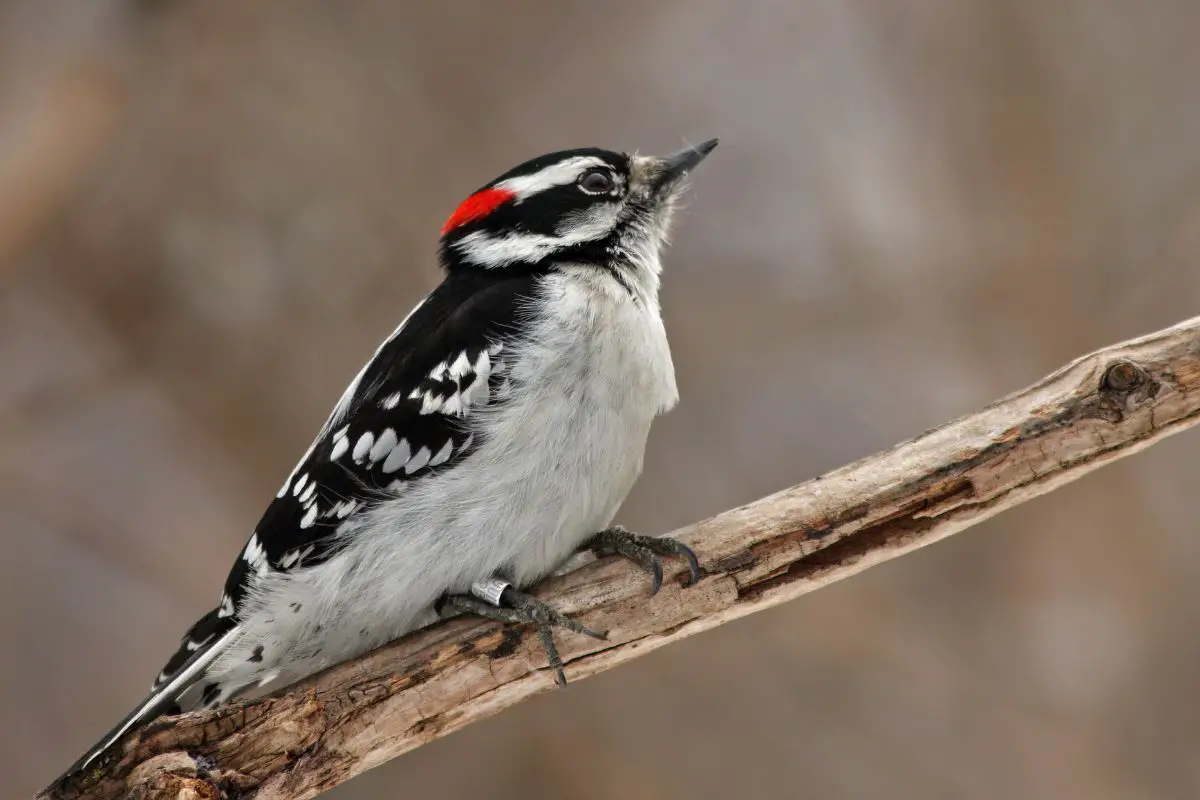
Downy Woodpeckers are mostly black and white with checkered spots on their wings. They have two stripes on their face, one above and one below the eye. There is a broad white stripe down their back and the males have a small red patch on the back of their heads.
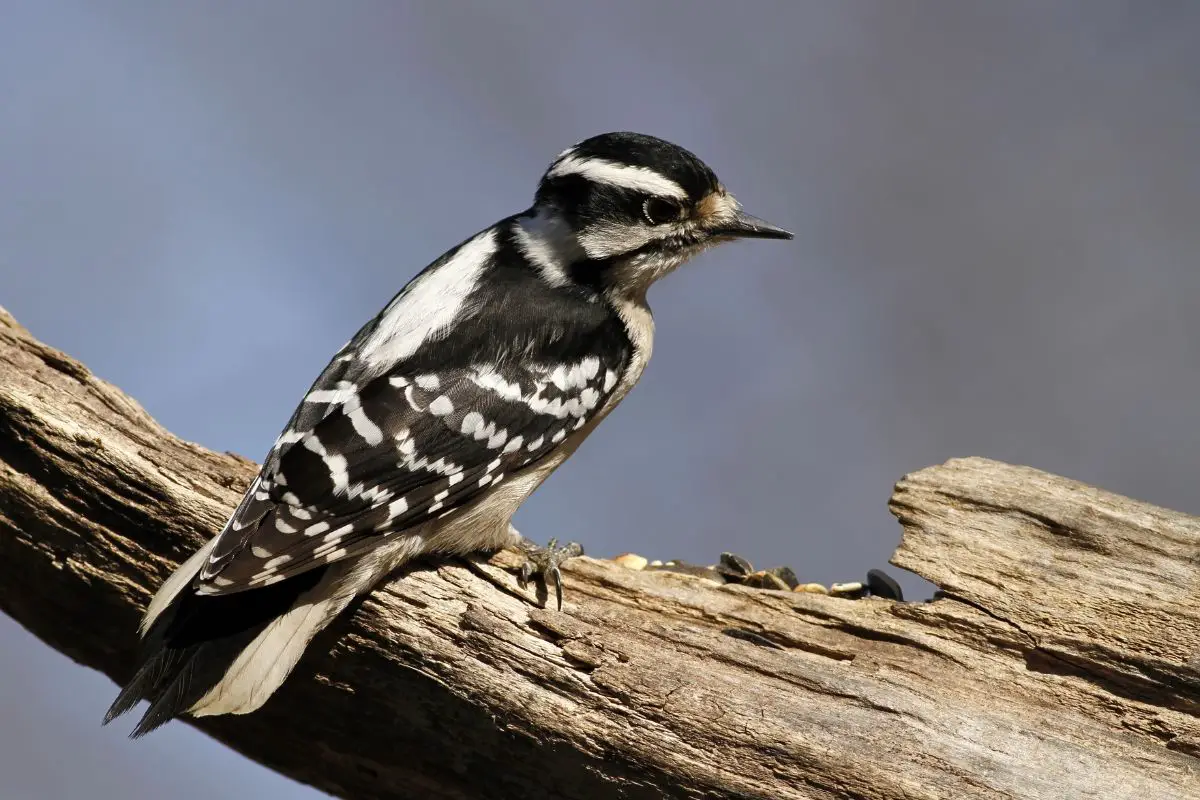
Downy Woodpeckers are mostly found in open woodlands, favoring deciduous trees and brushy or weedy edges. You may also find them in orchards, parks, vacant lots, or in your backyard.
Watch the Downy Woodpecker’s behavior and hear its call in this video by MyBackyardBirding:
References
- Bird distribution and other information – audubon.org
- Bird sizing information and other facts – allaboutbirds.org
- Additional information – Wikipedia
- Images sourced from – canva.com

